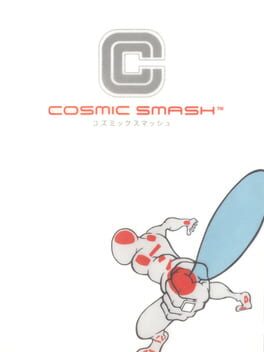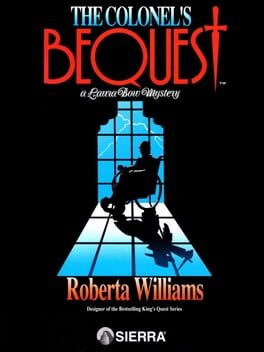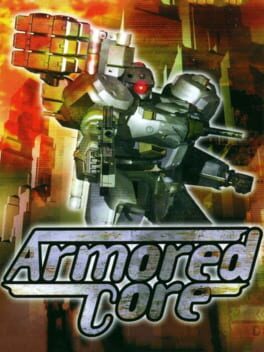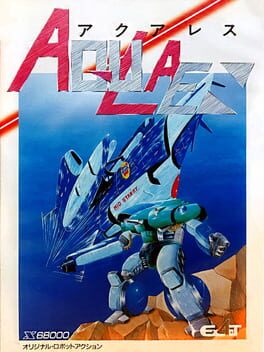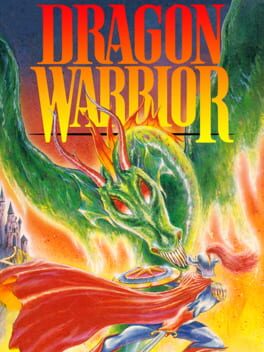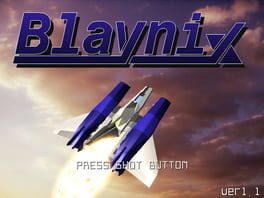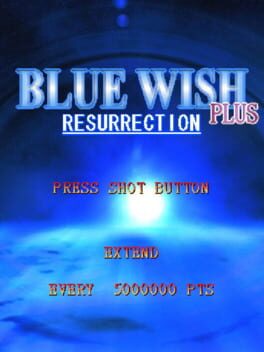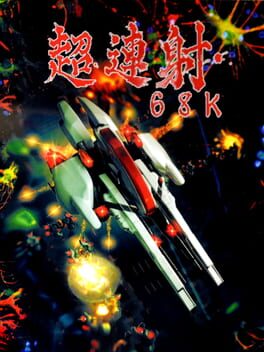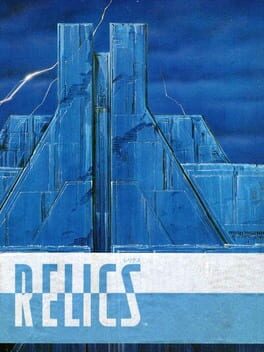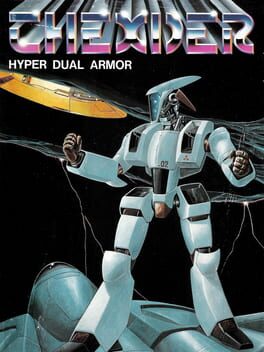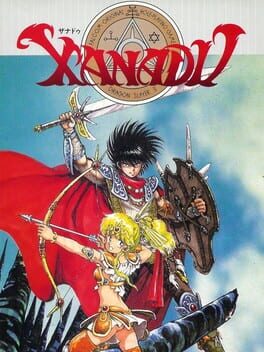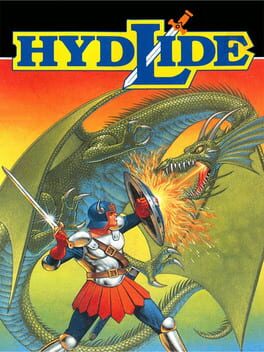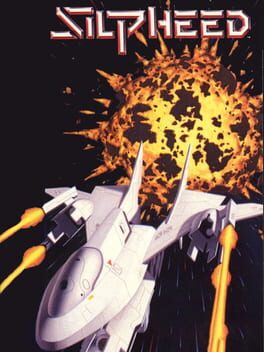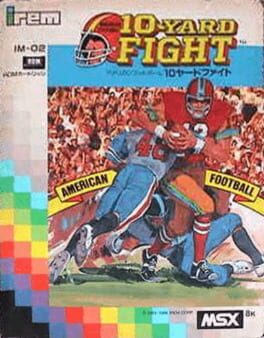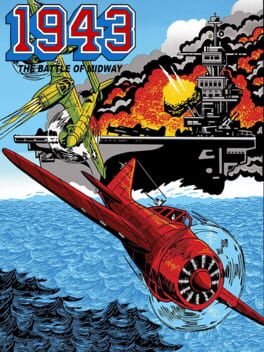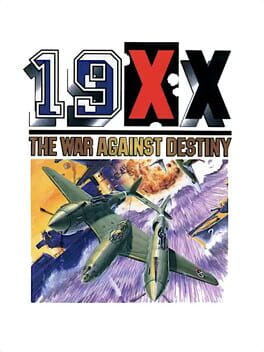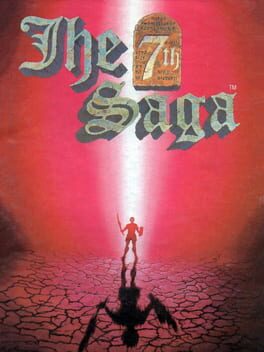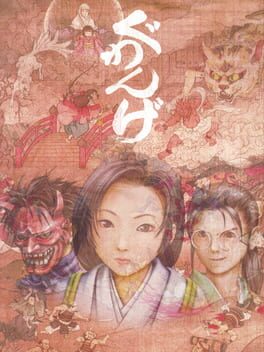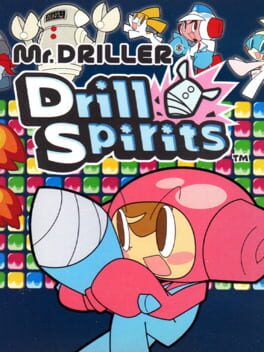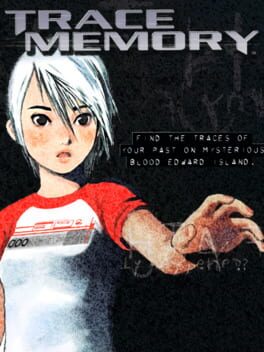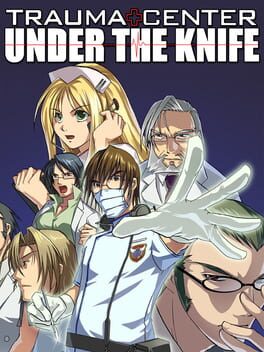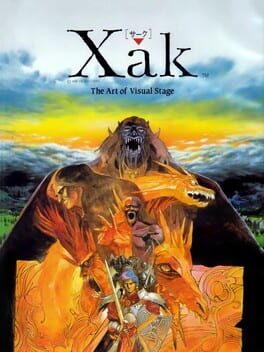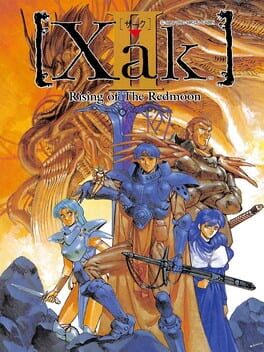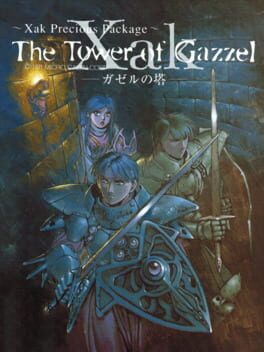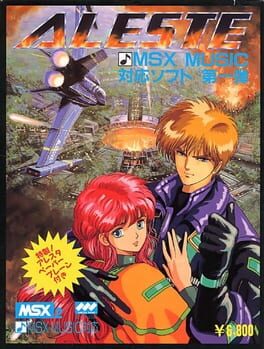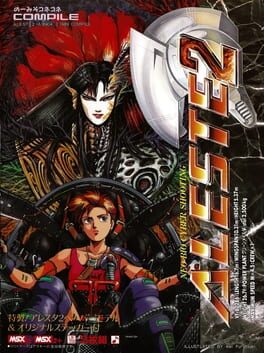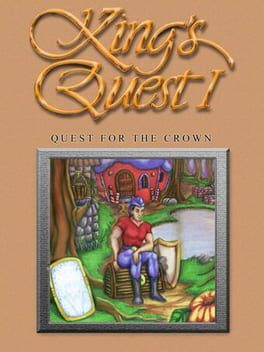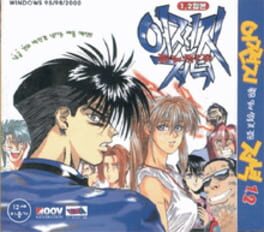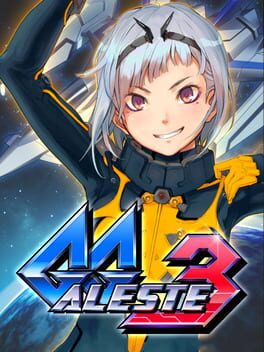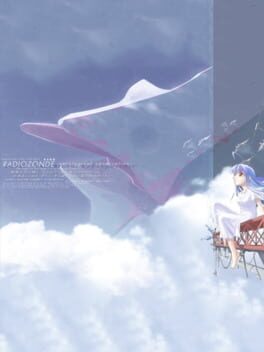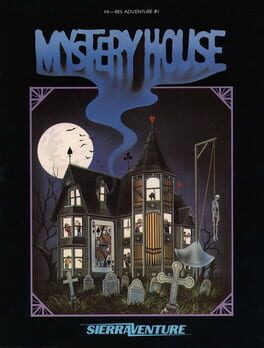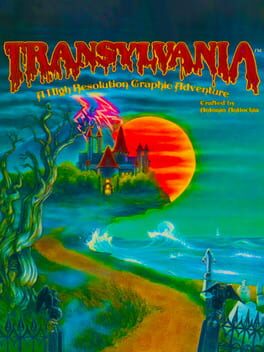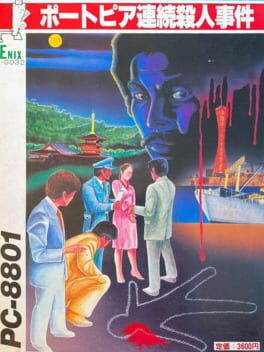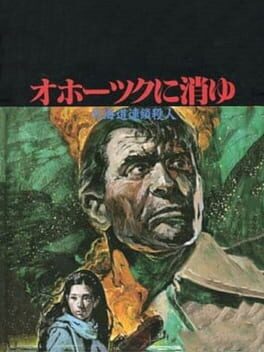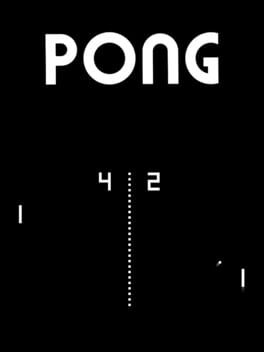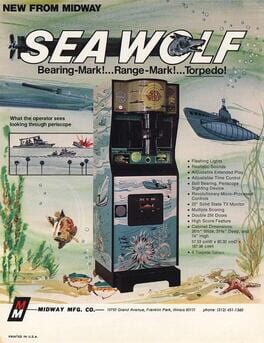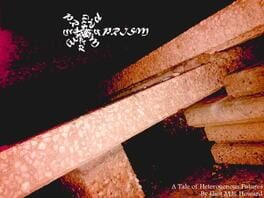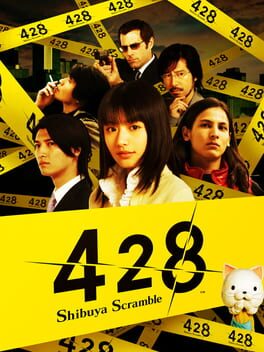abri
157 reviews liked by abri
Cosmic Smash
2001
cosmic smash sets the tone.
sonic adventure was a system seller, a response to nintendo's own 3D platformer which was sm64. however, games like Rez, L.O.L., Roommania and most importantly Cosmic Smash were political statements. it was a response not to one game but to the industry as a whole. that was sega saying "we are not afraid to experiment, and look at what that sentiment birthed".
sega gave their geniuses the platform and opportunity to shine. without worrying about money and profit, they allowed for odd and questionable ideas to become fully fletched experiences and the result was one of the best libraries of any videogame console ever. more importantly to this review is that this push of unadulterared >art< resulted in a strong and firm sense of style.
when people think of Y2K aesthetics, they're thinking of the dreamcast. they're thinking of Space Channel 5. they're thinking of Tomoko Sasaki's Serani Poji. they're thinking of Rez. but moreover, they're thinking exactly of Cosmic Smash.
a game that would give the guy who created VIDEOBALL a field day, a simple and finite one-player digital sport that gives the player set challenges that they can choose to overcome with whatever moviments they like. there's a time limit, but you don't need to worry about that when you already know how to control your character. it's ok, you'll make it. the challenges get trickier, but you get stronger, you create muscle memory and your own strategies to each stage. eventually you get a game over -- or you win, who knows -- and then, you think, "i'm gonna do it again".
all of that, of course, coated under the most clear cut and transparent display of what people would later call "Y2K aesthetics". so much in fact that it seems weird to think of cosmic smash as a part of the era and not the trend setter itself. the music, the textures, the lines, the minimalism, even the game design itself, all reek of the turn of the century. it's a more contained and quiet version of what Rez was doing, so it ends up being less eye catching but still beautiful. its minimalism also contrasts Rez's intricate design and artistic execution, being the exact opposite extreme, so it's sort of the anti-rez.
cosmic smash is an era defining statement, a tone-setter that feels like the cherry on top of the dreamcast library. anyone could play this, and everyone should.
sonic adventure was a system seller, a response to nintendo's own 3D platformer which was sm64. however, games like Rez, L.O.L., Roommania and most importantly Cosmic Smash were political statements. it was a response not to one game but to the industry as a whole. that was sega saying "we are not afraid to experiment, and look at what that sentiment birthed".
sega gave their geniuses the platform and opportunity to shine. without worrying about money and profit, they allowed for odd and questionable ideas to become fully fletched experiences and the result was one of the best libraries of any videogame console ever. more importantly to this review is that this push of unadulterared >art< resulted in a strong and firm sense of style.
when people think of Y2K aesthetics, they're thinking of the dreamcast. they're thinking of Space Channel 5. they're thinking of Tomoko Sasaki's Serani Poji. they're thinking of Rez. but moreover, they're thinking exactly of Cosmic Smash.
a game that would give the guy who created VIDEOBALL a field day, a simple and finite one-player digital sport that gives the player set challenges that they can choose to overcome with whatever moviments they like. there's a time limit, but you don't need to worry about that when you already know how to control your character. it's ok, you'll make it. the challenges get trickier, but you get stronger, you create muscle memory and your own strategies to each stage. eventually you get a game over -- or you win, who knows -- and then, you think, "i'm gonna do it again".
all of that, of course, coated under the most clear cut and transparent display of what people would later call "Y2K aesthetics". so much in fact that it seems weird to think of cosmic smash as a part of the era and not the trend setter itself. the music, the textures, the lines, the minimalism, even the game design itself, all reek of the turn of the century. it's a more contained and quiet version of what Rez was doing, so it ends up being less eye catching but still beautiful. its minimalism also contrasts Rez's intricate design and artistic execution, being the exact opposite extreme, so it's sort of the anti-rez.
cosmic smash is an era defining statement, a tone-setter that feels like the cherry on top of the dreamcast library. anyone could play this, and everyone should.
Truly my life continues to be run by anime RPGs but I’m breaking my head above water for only a moment to take one evening and return to Sierra On-Line a company whose work I admire probably more than I have liked so far (I looooove King’s Quest III but I could really take or leave those first two games). That all changed tonight though because The Colonel’s Bequest is one of the most charming little things I’ve ever had the joy to tinker around with for eight hours.
It’s a game of mixed identities – somewhere between the classically devilish, borderline bullying puzzles of the Sierra moment it actually belongs to and the more narrative focused, puzzle agnostic adventure games of the genre’s modern revival period; somewhere between an overtly parodic sendup of Agatha Christie-type adventures at large and And Then There Were None in particular and a sincere and spooky homage to it. In a company that was cranking out multiple series that were often differentiated largely by aesthetic sensibility, Laura Bow’s hell night stands out as structurally remarkable, even as it retains almost every core element that made Sierra famous.
It goes like this: reserved 1920s college student Laura Bow has been invited by her outgoing flapper friend Lillian to visit Lillian’s ancient rich grandfather’s estate on a shitty old plantation in the swamps outside New Orleans, where a weekend long family reunion will be taking place. Laura goes because this is a wild thing to get invited to, and indeed once everyone arrives the titular Colonel announces that when he dies his fortune will be split between all the present family members, unless of course any of them should die before he does, in which case everyone else’s shares will increase in size, a thing that is absolutely wild to say if you’re not planning on starting a death game, which he isn’t, but this doesn’t stop murders from immediately and mysteriously plaguing the evening.
So as Laura you’re in the lion’s den with a bunch of awful, shitty little people who all hate each other’s guts, trapped overnight in a swamp island with a killer that nobody else will believe is around and who is very good at hiding bodies after you find them. What you do in this game is Gather Evidence. And the way you gather evidence, almost exclusively, is by Eavesdropping and Spying. Everyone’s got their own rooms, and moves about the grounds and the manor on their business, and everyone has a web of twisted relationships with everyone else, and as Laura all you really need to do is Not Get Murdered for long enough to make it through the night, but if you have enough context for who is doing the killing and why to make some important decisions at the end of the game, well, that’s nice too.
That’s kind of the wild thing about Colonel’s Bequest: you could absolutely get through the entire game by fucking around and then arrive at the ending by accident, clueless, and come out on top. Laura is an extremely passive character, narratively speaking, and the main conflict is actually resolved offscreen for her to stumble upon sadly with a full chapter of game left to go. Her only lasting choice comes right at the end, where she decides which of the two other survivors to shoot as they try to kill each other, and one of them is distinctly innocent and while the other is NOT, they aren’t The Killer. The Killer’s been dead for over an hour. Nothing to do with you. In the bad ending, if you shoot the wrong guy, there’s nothing really that Laura can do about it but go along with how things have shaken out, and on the final screen of the game, as she’s being ferried back to her normal life she thinks to herself that this sucks, that this whole thing is so sad. “Poor Lillian,” she thinks. “Poor everyone.” But that’s true in the Good Ending too. Laura doesn’t do almost anything differently, and there’s not really any justice served that night. Just one act of petty selfishness prevented. It’s not nothing, but I wouldn’t be proud of it either.
There’s not a traditional Sierra style points system here, but rather a little meter that tells you how good of a detective you were with labels like “absent-minded” and “seasoned P.I.”, and then a little notebook that contains a checklist that really is a hint system telling you where you can look to dig into more of the game’s secrets and intricacies. The thing I kept coming back to was the classic Her Story Steam Forums “how do I know when I’m satisfied” post, because there’s literally no reason to investigate the game beyond your own interest, your own drive to uncover What Might Really Be Going On Here. There’s not even really a mystery to the game: the idea that the killer’s identity could even possibly be a mystery is ridiculous by the midpoint, so that by the time you get to any of the number of scenes that might constitute a big Revelation closer to the end, it’s more the culmination of a sickening feeling that’s been building in your gut, an understanding that you’re about to get closure. Laura can’t act on this obviousness, on knowledge that she has because you have it, so you’re just hurtling towards a conclusion that you know’s gonna be sad for everybody, and it is.
And when you go back for your second playthrough with a better understanding of all the secret areas and how best to interact with certain characters and what people’s schedules are like and when to spy on whom to ferret out the best secrets and get the most context for how things might have turned out the way they could have, you get the only answers you were ever possibly going to get: that these people are normal, and mean, and sad, and their stories are all mundane, and mean, and sad. And it sucks that they were murdered for this.
It’s such a weird feeling to have to sit with in a scenario where the guy the game is named for is also named after Colonel Mustard from Clue.
The vibe is really boosted by the presentation though. CB came out in 1989 and it’s easily the most beautiful 4-bit game I’ve ever seen. All sixteen colors are being utilized in the fullest, cleverest ways at all times – no object is every just a solid one or even two shades, but colored in with three or four colors to get depth and character, blended in ways you’d never expect them to be, ways that only a real master of the format would think to use. Basically everything is dithered, too, there’s dithering all over the damn place on every single screen, very few big flat textures here like you’d see in King’s Quest, which really helps sell both the ramshackle nature of the run down plantation house and the encroaching nature that surrounds its grounds. There are a few screens in the game that ditch the traditional perspectives and go for a zoomed in look at an object or location, like the controls or an elevator or a first-person perspective into a deep, dark well and these are highlight screens, always evocative of place, always full of feeling. Usually dread.
The soundscape is another thing that’s just nailed, usually by being totally silent. That’s not new for these games, for music and sound effects to be very selective, but here it feels purposeful rather than utilitarian. There COULD be more going on here sonically then there is, but Laura is in a strange place with strange people and one of them is a murderer. You don’t know their schedules, you don’t know where anyone is at a given time. It makes moments where you’re spontaneously grabbed by the killer or stumble into a corpse all the more shocking, and the silence in between ratchets up the tension. It starts bad and never ratchets down.
And of course, being a Sierra game, there are so many greebly little details, be they expressed via the absurd number of little quirks in the text parser, the outrageous attention paid to the tiniest details in the visual design, the scope of possible interactions you can both witness and instigate between the other guests even without Laura’s direct participation. And even the fact that every single guest has such a meticulously programmed schedule that they’ll stick to regardless of whether you’re there to see them doing it. Majora’s Mask a decade ahead of time and infinitely more complex in scale of interaction. Of course the game is buggy as shit but not as much as you might expect! It’s wild!
I don’t even know how much of the surface I’ve scratched with it. It’s such a gorgeous little thing, a puzzle box I’m having so much fun turning over in my head. I hope that I’ll search it up and find articles and documents and all kinds of shit digging into everything this game has going for it, how it all fits together. I’ve enjoyed the classic Sierra games I’ve played but compared to other adventure games they haven’t really been my cup of tea but bro I’d play fifty of this. I’d play a hundred of this. Laura Bow my beloved. Cannot believe they only made two of these.
It’s a game of mixed identities – somewhere between the classically devilish, borderline bullying puzzles of the Sierra moment it actually belongs to and the more narrative focused, puzzle agnostic adventure games of the genre’s modern revival period; somewhere between an overtly parodic sendup of Agatha Christie-type adventures at large and And Then There Were None in particular and a sincere and spooky homage to it. In a company that was cranking out multiple series that were often differentiated largely by aesthetic sensibility, Laura Bow’s hell night stands out as structurally remarkable, even as it retains almost every core element that made Sierra famous.
It goes like this: reserved 1920s college student Laura Bow has been invited by her outgoing flapper friend Lillian to visit Lillian’s ancient rich grandfather’s estate on a shitty old plantation in the swamps outside New Orleans, where a weekend long family reunion will be taking place. Laura goes because this is a wild thing to get invited to, and indeed once everyone arrives the titular Colonel announces that when he dies his fortune will be split between all the present family members, unless of course any of them should die before he does, in which case everyone else’s shares will increase in size, a thing that is absolutely wild to say if you’re not planning on starting a death game, which he isn’t, but this doesn’t stop murders from immediately and mysteriously plaguing the evening.
So as Laura you’re in the lion’s den with a bunch of awful, shitty little people who all hate each other’s guts, trapped overnight in a swamp island with a killer that nobody else will believe is around and who is very good at hiding bodies after you find them. What you do in this game is Gather Evidence. And the way you gather evidence, almost exclusively, is by Eavesdropping and Spying. Everyone’s got their own rooms, and moves about the grounds and the manor on their business, and everyone has a web of twisted relationships with everyone else, and as Laura all you really need to do is Not Get Murdered for long enough to make it through the night, but if you have enough context for who is doing the killing and why to make some important decisions at the end of the game, well, that’s nice too.
That’s kind of the wild thing about Colonel’s Bequest: you could absolutely get through the entire game by fucking around and then arrive at the ending by accident, clueless, and come out on top. Laura is an extremely passive character, narratively speaking, and the main conflict is actually resolved offscreen for her to stumble upon sadly with a full chapter of game left to go. Her only lasting choice comes right at the end, where she decides which of the two other survivors to shoot as they try to kill each other, and one of them is distinctly innocent and while the other is NOT, they aren’t The Killer. The Killer’s been dead for over an hour. Nothing to do with you. In the bad ending, if you shoot the wrong guy, there’s nothing really that Laura can do about it but go along with how things have shaken out, and on the final screen of the game, as she’s being ferried back to her normal life she thinks to herself that this sucks, that this whole thing is so sad. “Poor Lillian,” she thinks. “Poor everyone.” But that’s true in the Good Ending too. Laura doesn’t do almost anything differently, and there’s not really any justice served that night. Just one act of petty selfishness prevented. It’s not nothing, but I wouldn’t be proud of it either.
There’s not a traditional Sierra style points system here, but rather a little meter that tells you how good of a detective you were with labels like “absent-minded” and “seasoned P.I.”, and then a little notebook that contains a checklist that really is a hint system telling you where you can look to dig into more of the game’s secrets and intricacies. The thing I kept coming back to was the classic Her Story Steam Forums “how do I know when I’m satisfied” post, because there’s literally no reason to investigate the game beyond your own interest, your own drive to uncover What Might Really Be Going On Here. There’s not even really a mystery to the game: the idea that the killer’s identity could even possibly be a mystery is ridiculous by the midpoint, so that by the time you get to any of the number of scenes that might constitute a big Revelation closer to the end, it’s more the culmination of a sickening feeling that’s been building in your gut, an understanding that you’re about to get closure. Laura can’t act on this obviousness, on knowledge that she has because you have it, so you’re just hurtling towards a conclusion that you know’s gonna be sad for everybody, and it is.
And when you go back for your second playthrough with a better understanding of all the secret areas and how best to interact with certain characters and what people’s schedules are like and when to spy on whom to ferret out the best secrets and get the most context for how things might have turned out the way they could have, you get the only answers you were ever possibly going to get: that these people are normal, and mean, and sad, and their stories are all mundane, and mean, and sad. And it sucks that they were murdered for this.
It’s such a weird feeling to have to sit with in a scenario where the guy the game is named for is also named after Colonel Mustard from Clue.
The vibe is really boosted by the presentation though. CB came out in 1989 and it’s easily the most beautiful 4-bit game I’ve ever seen. All sixteen colors are being utilized in the fullest, cleverest ways at all times – no object is every just a solid one or even two shades, but colored in with three or four colors to get depth and character, blended in ways you’d never expect them to be, ways that only a real master of the format would think to use. Basically everything is dithered, too, there’s dithering all over the damn place on every single screen, very few big flat textures here like you’d see in King’s Quest, which really helps sell both the ramshackle nature of the run down plantation house and the encroaching nature that surrounds its grounds. There are a few screens in the game that ditch the traditional perspectives and go for a zoomed in look at an object or location, like the controls or an elevator or a first-person perspective into a deep, dark well and these are highlight screens, always evocative of place, always full of feeling. Usually dread.
The soundscape is another thing that’s just nailed, usually by being totally silent. That’s not new for these games, for music and sound effects to be very selective, but here it feels purposeful rather than utilitarian. There COULD be more going on here sonically then there is, but Laura is in a strange place with strange people and one of them is a murderer. You don’t know their schedules, you don’t know where anyone is at a given time. It makes moments where you’re spontaneously grabbed by the killer or stumble into a corpse all the more shocking, and the silence in between ratchets up the tension. It starts bad and never ratchets down.
And of course, being a Sierra game, there are so many greebly little details, be they expressed via the absurd number of little quirks in the text parser, the outrageous attention paid to the tiniest details in the visual design, the scope of possible interactions you can both witness and instigate between the other guests even without Laura’s direct participation. And even the fact that every single guest has such a meticulously programmed schedule that they’ll stick to regardless of whether you’re there to see them doing it. Majora’s Mask a decade ahead of time and infinitely more complex in scale of interaction. Of course the game is buggy as shit but not as much as you might expect! It’s wild!
I don’t even know how much of the surface I’ve scratched with it. It’s such a gorgeous little thing, a puzzle box I’m having so much fun turning over in my head. I hope that I’ll search it up and find articles and documents and all kinds of shit digging into everything this game has going for it, how it all fits together. I’ve enjoyed the classic Sierra games I’ve played but compared to other adventure games they haven’t really been my cup of tea but bro I’d play fifty of this. I’d play a hundred of this. Laura Bow my beloved. Cannot believe they only made two of these.
"I often think about that old metaphor, the one that says we are all islands on a wide sea. Especially these days, now that things are more difficult than before and the world appears to be harsher than we once imagined it to be. We are all like islands, the philosopher said. Perhaps it's true. Yet I cannot help but remember an older saying, scratched on a cave wall somewhere by a long-forgotten prophet: in the end, the sea will claim everything."
If you've read any of my recent reviews lately, you might be able to tell that I've sort of been in a pickle. I've felt a bit restless yet exhausted trying out different things only for nothing to seemingly stick; Deus Ex is always just a bit too much for my tired mind after a long day at work (and I suck at stealth), Skies of Arcadia looks and sounds so cool but right now it feels a bit too drawn-out for my fickle being, Muv-Luv is filled with these loud characters that seem to just act at their own whim, the older Ys games I've tried have been pretty fun but haven't lived up to Origin or Lacrimosa of Dana, and party game weekend was lightning in a bottle that quite frankly, I'm not sure I really ever want to go through or attempt to capture again. And it makes me wonder, where I went wrong to make gaming feel less like a hobby and more like a chore. But playing through Root Film recently got me thinking that maybe, I should just go back to the classics for a bit.
I don't usually take the time to replay older games I've enjoyed. My backlog is bursting with titles (and only gets larger when my friends dig up yet another dusty title that they played back in the day), and I'd like to think I'm past those days of mindlessly comboing CPUs in Rivals of Aether to instrumental music. And even if I were to revisit some favorites, point and clicks don't tend to fall on that list; they're great for a quick fix of adventure and simple puzzle solving, and you move on with your day, never to play it again because you've seen it all. That said, The Sea Will Claim Everything continues to stand out in my memory, so... why not revisit it to find out why?
This is probably one of the harder reviews that I have had to write; I can usually pin down exactly why I like or dislike certain games due to specific gameplay elements and features, and as such most of my reviews tend to be more mechanically focused. But how do you even begin describing a game like The Sea Will Claim Everything? It is about as barebones as a point and click adventure game can get. There's no dragging items to and from an inventory for interaction; the usual motley of "verbs" for interacting with objects have been replaced with 4 buttons describing the human senses. Most of the game involves clicking and reading text with no voice acting or animations, and many of the "puzzles" could be simplified as straight fetch quests. And finally, there really aren't any forced "gameplay" execution tests to be found here; what you see is what you get.
And yet, I am confident that this is still the most distinct point and click adventure game I've ever played. The game will outright start by telling you that time behaves differently in the Land of Dream; it warns you that if you try to interact with things at a similar pace to our world, you might find the whole experience outright unpleasant. So take your time and just soak in the moment, observing all you see and can click on. And it's absolutely worthwhile to do so; embedded in the game are tons of silly references, jokes, narratives, flights of fancy, and much more. The game walks this tightrope between being too other-worldly versus being too rooted in reality, but it just understands how to capture its wistfulness well without feeling too heavy. It's not afraid to break the fourth wall every now and then alongside its philosophical tangents, but it's also subtly daring in how it tightly constructs its surrealist world with so many varied and colorful locations and individuals. There's a lot to unpack from speaking with everyone in this evocative and unfamiliar world, and plenty of bright and whimsical moments to be found alongside the pangs of yesterday. And despite this world feeling so unknown, it's deeply humanizing in how it emphasizes connection and reminds us all that there is so much we share despite our differences. It's such a mood that I've never quite experienced to this extent in any point and click adventure game I've ever played, and maybe any video game I've played to this day.
Fun fact by the way, did you know that this is written by Jonas Kyratzes, one of the writers of the Talos Principle? Or that Chris Christodoulou, the composer of the Risk of Rain soundtracks, handled the music for this game? I only just found out about this now, but it's such an interesting collaboration between two greats that have handled such different works in video games. (Go check out Jonas Kyratzes' other works by the way, they're all just as strange and as fascinating as this one!)
So I'm left with not enough words and not enough time to really decipher exactly how to put it all down. The fanciful hand drawn graphics, the contemplative tinkering background tunes, the flurry of silly jokes and references scattered across the dreamy landscapes, and the messages sent and felt through the window; it all comes together almost seamlessly and I can't imagine how it would play out any other way. You just have to experience this for yourself to really capture an understanding for what makes this seemingly innocent title so powerful. It's fantastical yet familiar, simple yet layered, and nostalgic yet unafraid of the future. I think we could all learn something from The Sea Will Claim Everything, in that it never forgets to emphasize how important it is to enjoy the now and then; I sure know I won't be forgetting about this anytime soon.
If you've read any of my recent reviews lately, you might be able to tell that I've sort of been in a pickle. I've felt a bit restless yet exhausted trying out different things only for nothing to seemingly stick; Deus Ex is always just a bit too much for my tired mind after a long day at work (and I suck at stealth), Skies of Arcadia looks and sounds so cool but right now it feels a bit too drawn-out for my fickle being, Muv-Luv is filled with these loud characters that seem to just act at their own whim, the older Ys games I've tried have been pretty fun but haven't lived up to Origin or Lacrimosa of Dana, and party game weekend was lightning in a bottle that quite frankly, I'm not sure I really ever want to go through or attempt to capture again. And it makes me wonder, where I went wrong to make gaming feel less like a hobby and more like a chore. But playing through Root Film recently got me thinking that maybe, I should just go back to the classics for a bit.
I don't usually take the time to replay older games I've enjoyed. My backlog is bursting with titles (and only gets larger when my friends dig up yet another dusty title that they played back in the day), and I'd like to think I'm past those days of mindlessly comboing CPUs in Rivals of Aether to instrumental music. And even if I were to revisit some favorites, point and clicks don't tend to fall on that list; they're great for a quick fix of adventure and simple puzzle solving, and you move on with your day, never to play it again because you've seen it all. That said, The Sea Will Claim Everything continues to stand out in my memory, so... why not revisit it to find out why?
This is probably one of the harder reviews that I have had to write; I can usually pin down exactly why I like or dislike certain games due to specific gameplay elements and features, and as such most of my reviews tend to be more mechanically focused. But how do you even begin describing a game like The Sea Will Claim Everything? It is about as barebones as a point and click adventure game can get. There's no dragging items to and from an inventory for interaction; the usual motley of "verbs" for interacting with objects have been replaced with 4 buttons describing the human senses. Most of the game involves clicking and reading text with no voice acting or animations, and many of the "puzzles" could be simplified as straight fetch quests. And finally, there really aren't any forced "gameplay" execution tests to be found here; what you see is what you get.
And yet, I am confident that this is still the most distinct point and click adventure game I've ever played. The game will outright start by telling you that time behaves differently in the Land of Dream; it warns you that if you try to interact with things at a similar pace to our world, you might find the whole experience outright unpleasant. So take your time and just soak in the moment, observing all you see and can click on. And it's absolutely worthwhile to do so; embedded in the game are tons of silly references, jokes, narratives, flights of fancy, and much more. The game walks this tightrope between being too other-worldly versus being too rooted in reality, but it just understands how to capture its wistfulness well without feeling too heavy. It's not afraid to break the fourth wall every now and then alongside its philosophical tangents, but it's also subtly daring in how it tightly constructs its surrealist world with so many varied and colorful locations and individuals. There's a lot to unpack from speaking with everyone in this evocative and unfamiliar world, and plenty of bright and whimsical moments to be found alongside the pangs of yesterday. And despite this world feeling so unknown, it's deeply humanizing in how it emphasizes connection and reminds us all that there is so much we share despite our differences. It's such a mood that I've never quite experienced to this extent in any point and click adventure game I've ever played, and maybe any video game I've played to this day.
Fun fact by the way, did you know that this is written by Jonas Kyratzes, one of the writers of the Talos Principle? Or that Chris Christodoulou, the composer of the Risk of Rain soundtracks, handled the music for this game? I only just found out about this now, but it's such an interesting collaboration between two greats that have handled such different works in video games. (Go check out Jonas Kyratzes' other works by the way, they're all just as strange and as fascinating as this one!)
So I'm left with not enough words and not enough time to really decipher exactly how to put it all down. The fanciful hand drawn graphics, the contemplative tinkering background tunes, the flurry of silly jokes and references scattered across the dreamy landscapes, and the messages sent and felt through the window; it all comes together almost seamlessly and I can't imagine how it would play out any other way. You just have to experience this for yourself to really capture an understanding for what makes this seemingly innocent title so powerful. It's fantastical yet familiar, simple yet layered, and nostalgic yet unafraid of the future. I think we could all learn something from The Sea Will Claim Everything, in that it never forgets to emphasize how important it is to enjoy the now and then; I sure know I won't be forgetting about this anytime soon.
Armored Core
1997
Humanity sleeps in the machine. It gurgles for breath, suffocating beneath smoke and gunfire within the netherworld. I grip the joystick with hands like claws; the sweat feels wrong, like oil on water. Heads-up display signals flare all around my vision as I wrench the exoskeletal warrior through warehouses, space stations, and forlorn caverns. When the foes aren't robots, they're pilots just as feckless and desperate as I. The job is king—morals are optional. Captains of industry march us inexorably towards doom, and I'm just trying to keep my head down, chin up against the rising tide. The harder I fight, the deeper I explore, the more I sense the great chain of being start to fray.
Armored Core…that pit of vitality lying within the most veteran of mercenaries, and an apt title for the series to follow King's Field. From Software staff would tell us they bungled their way into developing this game to begin with, but it's appropriate they'd shift from one dark fantasy to another. Both series deal in obscure, arcane worlds, just with divergent approaches to non-linearity and game complexity. They started life as 3D tech demos before unfolding into realms of mystery and danger hitherto unseen on consoles—the kind of innovative experience Sony hoped would set their PlayStation apart from the competition. And for all the nitpicks and missed potential I can (and will) bring up, it's impressive how effectively this studio captured the one-man-army appeal of mecha media versus other developers' outings at the time. From a simple animation test to one of the studio's core franchises, it's a hell of a leap. [1]
| From this point on, you are…a Raven… |
Mecha action games on the PlayStation weren't in short supply before Armored Core (AC) arrived, though I'd forgive you for believing that. The earliest examples—Metal Jacket, Robo Pit, and Extreme Power—all featured some amount of mech customization and variety in scenarios, but always with caveats. None of them had the storytelling emphasis that From Soft's game introduced. At most, Extreme Power let players choose which missions to attempt first, acquiring points to buy new parts if successful. But that still lacked elements like e-mail chains and running a deficit after overusing ammo and/or failing missions. Robo Pit introduced the extensive parts system within a 3D versus fighter context, and Metal Jacket focused on simpler open-field battles a la MechWarrior. (Though the latter remains maybe the biggest influence on so many mecha games to come, it didn't receive a PS1 port until the same year as Armored Core.)
If anything, I see a lot of commonality between the first AC and Front Mission: Gun Hazard, the latter releasing in 1996 with some notability. Combining the series' heavy geopolitical tone and intrigue with a game loop and structure akin to Assault Suit Valken, Squaresoft's game reviewed well and prefigured the genre hybrids they'd produce for Sony's machine. Critically, they also reworked the parts-as-equipment framework from Front Mission, balancing it with arcade-style pacing and more wiggle room for players wanting to test drive multiple builds. The trouble with mecha xRPGs, then and now, is motivating constant character creation (aka editing your mecha) in order to complete stages, ideally while avoiding damage and long-term costs that could ruin a playthrough. I have no way of knowing if the original AC devs were familiar with Gun Hazard and how it elegantly solves these issues via its mix of complex story, set-pieces, and missions designed to reward creativity.
It's hard enough to make a sci-future this dreadful so enchanting and replayable. Armored Core's semi-linear plot and trickle feed of environmental worldbuilding go far in reifying the player's ascension to ace pilot, a new hero of chaos. People are right to point out the jarring, confrontational "initiation" battle, a middle finger to trends of tutorialization beginning in the mid-'90s. Surviving this teaches one to never fully trust the world they're thrust into, be it the obtuse mecha controls or the machinations of agents, corporations, and other Ravens contracting and challenging you. The fun comes from accepting these additive layers of masochism, a reflection of the decaying worldview which From Soft presents without irony or pomp and circumstance. It's on the player to investigate and understand their predicament. Future series entries add fleeting moments of cooperation and optimism to mitigate the grim bits, but the tone here's consistently muted and adverse. Absent are the triumphant flourishes of Gundam or even VOTOMS, replaced by an engaging but ever-present indifference to the erasure of people and elevation of proxy warfare.
| You have the right…the duty to find out. |
Opening missions in this game settle into a formula of scout, destroy, rinse and repeat, followed by a shopping spree. It's never quite as comfortable as you'd hope; browsing for a new radar attachment after gunning down protesters feels ever so morbid. Nor are you interacting with fellow Ravens during the majority of a playthrough, instead fighting or helping a select few through happenstance. Armored Core keeps players at arm's length from the consequences they wreak upon the world, often chiding them through AI monologues and tetchy e-mail chains. This odd pacing and story presentation lets From Soft transition between unusual missions and plot beats without breaking a sweat. The further you work for Chrome or Murakumo to the other's downfall, the murkier the mystery gets, with ulterior motives of anonymous agents pressuring you into service.
Thankfully there's a decently balanced in-game economy to support the amount of experiments and risk-taking the campaign requires, though not without problems. Buying and selling are 1-to-1 on cash return; you'll never enter the red just through shopping. Instead, the way most players wreck their run is by abusing ammo-based weapons and continuing after failing missions with mech damage. Save scumming isn't a thing Armored Core looks down on, but it will go out of its way to promote ammo-less tactics with energy swords and simply dodging past optional foes. Around halfway through the game, it arguably becomes more important to scour levels for hidden parts instead of relying on the diminishing returns from Raven's Nest inventory. I wish this first entry had done better at keeping the market relevant, but it wasn't to be.
My go-to build throughout the story was an agile, energy-focused quadrupedal range specialist dressed to the nines with secret parts. (If the game let me use the Karasawa with these legs, oh boy would I have been unstoppable!) Sure, there's a lot of fun one can have with beefy machine guns and missile options, but getting the most cash out of missions requires plasma rifles and mastery of lightsaber stabbing to play efficiently. While Project Phantasma struggled to balance the economy back towards non-energy offense, it wouldn't be until Master of Arena that the series largely evened out the trade-offs between common mecha archetypes. For instance, tank-tread mecha in this first game are actually damn powerful due to a lack of movement tricks for the bipeds, but it all falls apart when it's time for platforming or quickly escaping. Bipeds often get the class-favorite treatment in this genre, yet struggle to wield a variety of parts and weapons to handle most challenges this game throws at you later on. That leaves quad-legs builds as the most flexible and resilient option at higher levels of play, a flawed but interesting subversion of what's usually seen in mecha anime and manga. (Ed: Yes, I'm aware reverse joint legs exist. No, I don't use them in a game that punishes jumping all the time. Later AC games handle it better.)
With all these incentives combined, the pressure to learn the classic Armored Core control scheme and physics becomes bearable, if still overbearing. I've come from other tank-y mecha games like Gungriffon, so the adjustment period wasn't too bad for me, but I get why many newcomers stick with analog-patched versions of the earlier entries. Memorizing the timings for boosting before landing to minimize lag, or how to effectively pitch the lock-on reticule and snap back to center, matters more than anything in the first couple of hours. Then add on tricks for circle strafing back away from enemies, often while firing guns or launching missiles, and the combat evolves from awkward plodding into a dance of destruction. And there's no arena mode here to let you practice these techniques in a consistent, scaling environment. A veteran Raven or horse of robots can descend upon you in any of the mid-game/late-game missions, requiring quick reactions and establishing a zone of control (or retreat). It's sink or swim in the truest sense. Past the teething phase, it's easy to return to this control scheme and feel one with the AC, even after years have passed. I won't doubt that full dual-stick analog controls will work even better and enable a longer skill progression, but I adapted to the famous claw-grip style quicker than expected.
| "Pledge allegiance to no one!" |
Any problems significant enough to keep Armored Core below a 4-out-of-5 rating or higher must be deep-rooted in the game's loop and structure; that's sadly true for the level and encounter design here. I'm far from opposed to dungeon crawling in my semi-linear mecha action-RPGs, at least when there's room enough to blast around duels (plus verticality to reduce the claustrophobia). Still, a few too many stages in this debut feel like holdover concepts from King's Field II instead of properly scaled settings to wrangle a mech through. The difference between enjoying "Kill 'Struggle' Leader" and dreading "Destroy Base Computer" boils down to whether or not the story framing is compelling enough to justify zooming through non-descript (though nicely textured) hallways for most of their runtime. Occasionally the designers get clever with metal-corroding gas, inconveniently placed explosives, and other traps to keep the spelunking varied; I had a hoot tearing through the insectoid lairs like I was playing an antique musou game! But later series installments improved these confined missions with more arena-like rooms and affordances to players who make it far in and then can't win due to a sub-optimal build.
If I had to speculate, wide open-ended maps are less common here simply due to hardware constraints, be it rendering ACs and other actors in any abundance (regardless of level-of-detail scaling) or the enemy AI struggling with pathfinding in combat on a broader scale. It's a shame regardless since bombarding installations across water ("Reclaim Oil Facility"), going en guarde with a berserker atop a skyscraper ("Destroy Plus Escapee"), and rampaging down public avenues ("Attack Urban Center") offer some of the best thrills in Armored Core. Objective variety and complexity never reaches especially high regardless of mission category, so just getting to rip up groups of MTs, droids, and ACs goes a long way. Defending a cargo train in the desert starts off humble, then escalates to defeating a full-bore Human Plus combatant interceding on the situation. A series of undersea tunnels and chambers, well-defended and secretly primed to implode, threaten to bury you while avenues of escape close off. A select few dungeon crawls also open up in unexpected ways, particularly those set on space stations where vertical engagements come into play. I didn't think mecha and sewer levels could work, but here I am grinning as I pursue Struggle operatives down waterways or methodically undo their bombs within a rat's maze of air treatment tunnels.
Armored Core rarely has bad missions so much as disappointing or overachieving ones, which makes the finale so uniquely odd. By this point, the entropic cycle ensnaring Chrome, Murakumo, Struggle, and adjacent organizations has caused untold devastation across the earth. Now even the Raven's Nest falls, revealed as the illusory sham of governance it always was. Even bit players in the narrative pitch in, waxing over e-mail about the futility of these conflicts and what's really driving it all behind the scenes. So, with all this build-up and conspiracy baiting, I had high hopes for the last hour, wishing for an epic battle and world-shattering revelations to boot. Sure, I got the latter (if in a minimal, trope-adherent form), but instead of satisfying gladiatorial action, I had to ascend the fucking cubes. Everyone's got a horror story about "Destroy Floating Mines", it seems, and I'm just glad to have survived this much awkward, drawn-out platforming using my quad-leg AC. Squaring off against Nine-Ball afterward isn't quite enough to compensate either, not unless you can have an even pitched fight against this iconic rival and win the first couple of attempts. (The penultimate chambers also reflect poorly on the camera's ability to track fast-moving combatants, even if it makes for an exciting sequence.) I can still appreciate how From Soft didn't explicate too much at the end, instead trying to confound players with interesting questions and non sequiturs in the level design itself. It's all a big joke and we get to grimace through it.
| Shape Memory Alloys |
In conclusion, it's a good thing From Soft nailed all their game loop, distinctive mechanics, and interweaving systems here. The original Armored Core is unfortunately limited with how it challenges players, both in level design and mission pacing. Not having an arena to lean on makes completing the missions with maximum efficiency more of a priority, which can lead to excess retries and scrimping on investments in hopes of affording something better later vs. smoother upgrades in the short term. (I do appreciate how only fighting other ranked ACs within missions makes the Ravens' dynamic more hostile and contradictory, but the game does so little to expand on that angle.) These problems sting less knowing that, as a prototype of adventures to come, this game still accomplishes so much with so little.
Not many series strive to reach a profile this high while teasing players with details out of reach and mysteries about its development unanswered. Anyone invested in the wider world Armored Core hints at, from the shadowy groups running these underground beehive cities to the horrors hiding behind Human Plus, has to read through "data books" (artbooks) and track down magazine previews for scraps. We're only now getting English translations of the artbooks and related articles, all of which are coloring the fringes of the AC universe while only letting trace amounts of humanity through the barrier [2]. And as far as these games are concerned, pilots' backstories and white papers on neural augmentation procedures amount to nothing. Heroes and villains drop in and out of history like mayflies—only shocks to the system register on the scale From Soft's using. We're just along for the ride.
It feels like there's still so much else to analyze here: how the studio crowbar-ed their King's Field engine into handling these pyrotechnics, the peculiarities of Human Plus endings as difficulty modifiers, let alone the timely yet appropriate electronica soundtrack. A lot of PS1 releases from this period struggle to make the best use of their developers' skills, assets, and remaining CD space. I wouldn't say Armored Core succeeds at the latter, using only a few FMV sequences at key points in the story, but it's a remarkably lean and appealing game relative to its own premise. Replays come naturally thanks to multiple Human Plus tiers and the freedom to play all missions upon completing the story (plus making new saves to transfer into Project Phantasma). The controls here, though lacking in finesse, carry forward into a good chunk of the later games, with concepts like boost canceling staying relevant even after the switch to analog. Contrast this maturity with all the pratfalls From Soft made during their King's Field days. They'd learned how to not just lead in with a better start, but retain their creative momentum on budgets larger and smaller with each sequel.
Armored Core represents a coming-of-age for the PlayStation as it entered the midpoint of its lifespan, setting a bar other mid-sized studios could aspire to. Its rough edges hardly mar what I'd call one of my favorite experiences in the system's library so far. Maybe I'm going easier on this one due to my enthusiasm for the genre and the myriad themes this game explores, from cyberpunk dystopia to the malleability of history in the post-modern. It could just be that the core game's so, uh, solid after all this time. I chose not to rely on Human Plus for my first playthrough and that might have helped. No matter how you approach the series today, it's awesome to see it debut this confidently, and plenty of players must have thought so too. The Armored Core series became From Soft's backbone for a decade before the Souls-likes came to replace it, and what AC achieved for mecha games (and ARPGs in general) can't be overstated.
| Bibliography |
[1] Alex “blackoak,” trans. “Armored Core – 1997 Developer Interview - Shmuplations.Com.” PlayStation Magazine. 1997. Shmuplations. https://shmuplations.com/armoredcore/.
[2] Reddit. “Translations of Pages 103 to 105 from the Book Armored Core Official Data Book.” Accessed January 14, 2024. https://www.reddit.com/r/armoredcore/comments/x940dj/translations_of_pages_103_to_105_from_the_book/.
Armored Core…that pit of vitality lying within the most veteran of mercenaries, and an apt title for the series to follow King's Field. From Software staff would tell us they bungled their way into developing this game to begin with, but it's appropriate they'd shift from one dark fantasy to another. Both series deal in obscure, arcane worlds, just with divergent approaches to non-linearity and game complexity. They started life as 3D tech demos before unfolding into realms of mystery and danger hitherto unseen on consoles—the kind of innovative experience Sony hoped would set their PlayStation apart from the competition. And for all the nitpicks and missed potential I can (and will) bring up, it's impressive how effectively this studio captured the one-man-army appeal of mecha media versus other developers' outings at the time. From a simple animation test to one of the studio's core franchises, it's a hell of a leap. [1]
| From this point on, you are…a Raven… |
Mecha action games on the PlayStation weren't in short supply before Armored Core (AC) arrived, though I'd forgive you for believing that. The earliest examples—Metal Jacket, Robo Pit, and Extreme Power—all featured some amount of mech customization and variety in scenarios, but always with caveats. None of them had the storytelling emphasis that From Soft's game introduced. At most, Extreme Power let players choose which missions to attempt first, acquiring points to buy new parts if successful. But that still lacked elements like e-mail chains and running a deficit after overusing ammo and/or failing missions. Robo Pit introduced the extensive parts system within a 3D versus fighter context, and Metal Jacket focused on simpler open-field battles a la MechWarrior. (Though the latter remains maybe the biggest influence on so many mecha games to come, it didn't receive a PS1 port until the same year as Armored Core.)
If anything, I see a lot of commonality between the first AC and Front Mission: Gun Hazard, the latter releasing in 1996 with some notability. Combining the series' heavy geopolitical tone and intrigue with a game loop and structure akin to Assault Suit Valken, Squaresoft's game reviewed well and prefigured the genre hybrids they'd produce for Sony's machine. Critically, they also reworked the parts-as-equipment framework from Front Mission, balancing it with arcade-style pacing and more wiggle room for players wanting to test drive multiple builds. The trouble with mecha xRPGs, then and now, is motivating constant character creation (aka editing your mecha) in order to complete stages, ideally while avoiding damage and long-term costs that could ruin a playthrough. I have no way of knowing if the original AC devs were familiar with Gun Hazard and how it elegantly solves these issues via its mix of complex story, set-pieces, and missions designed to reward creativity.
It's hard enough to make a sci-future this dreadful so enchanting and replayable. Armored Core's semi-linear plot and trickle feed of environmental worldbuilding go far in reifying the player's ascension to ace pilot, a new hero of chaos. People are right to point out the jarring, confrontational "initiation" battle, a middle finger to trends of tutorialization beginning in the mid-'90s. Surviving this teaches one to never fully trust the world they're thrust into, be it the obtuse mecha controls or the machinations of agents, corporations, and other Ravens contracting and challenging you. The fun comes from accepting these additive layers of masochism, a reflection of the decaying worldview which From Soft presents without irony or pomp and circumstance. It's on the player to investigate and understand their predicament. Future series entries add fleeting moments of cooperation and optimism to mitigate the grim bits, but the tone here's consistently muted and adverse. Absent are the triumphant flourishes of Gundam or even VOTOMS, replaced by an engaging but ever-present indifference to the erasure of people and elevation of proxy warfare.
| You have the right…the duty to find out. |
Opening missions in this game settle into a formula of scout, destroy, rinse and repeat, followed by a shopping spree. It's never quite as comfortable as you'd hope; browsing for a new radar attachment after gunning down protesters feels ever so morbid. Nor are you interacting with fellow Ravens during the majority of a playthrough, instead fighting or helping a select few through happenstance. Armored Core keeps players at arm's length from the consequences they wreak upon the world, often chiding them through AI monologues and tetchy e-mail chains. This odd pacing and story presentation lets From Soft transition between unusual missions and plot beats without breaking a sweat. The further you work for Chrome or Murakumo to the other's downfall, the murkier the mystery gets, with ulterior motives of anonymous agents pressuring you into service.
Thankfully there's a decently balanced in-game economy to support the amount of experiments and risk-taking the campaign requires, though not without problems. Buying and selling are 1-to-1 on cash return; you'll never enter the red just through shopping. Instead, the way most players wreck their run is by abusing ammo-based weapons and continuing after failing missions with mech damage. Save scumming isn't a thing Armored Core looks down on, but it will go out of its way to promote ammo-less tactics with energy swords and simply dodging past optional foes. Around halfway through the game, it arguably becomes more important to scour levels for hidden parts instead of relying on the diminishing returns from Raven's Nest inventory. I wish this first entry had done better at keeping the market relevant, but it wasn't to be.
My go-to build throughout the story was an agile, energy-focused quadrupedal range specialist dressed to the nines with secret parts. (If the game let me use the Karasawa with these legs, oh boy would I have been unstoppable!) Sure, there's a lot of fun one can have with beefy machine guns and missile options, but getting the most cash out of missions requires plasma rifles and mastery of lightsaber stabbing to play efficiently. While Project Phantasma struggled to balance the economy back towards non-energy offense, it wouldn't be until Master of Arena that the series largely evened out the trade-offs between common mecha archetypes. For instance, tank-tread mecha in this first game are actually damn powerful due to a lack of movement tricks for the bipeds, but it all falls apart when it's time for platforming or quickly escaping. Bipeds often get the class-favorite treatment in this genre, yet struggle to wield a variety of parts and weapons to handle most challenges this game throws at you later on. That leaves quad-legs builds as the most flexible and resilient option at higher levels of play, a flawed but interesting subversion of what's usually seen in mecha anime and manga. (Ed: Yes, I'm aware reverse joint legs exist. No, I don't use them in a game that punishes jumping all the time. Later AC games handle it better.)
With all these incentives combined, the pressure to learn the classic Armored Core control scheme and physics becomes bearable, if still overbearing. I've come from other tank-y mecha games like Gungriffon, so the adjustment period wasn't too bad for me, but I get why many newcomers stick with analog-patched versions of the earlier entries. Memorizing the timings for boosting before landing to minimize lag, or how to effectively pitch the lock-on reticule and snap back to center, matters more than anything in the first couple of hours. Then add on tricks for circle strafing back away from enemies, often while firing guns or launching missiles, and the combat evolves from awkward plodding into a dance of destruction. And there's no arena mode here to let you practice these techniques in a consistent, scaling environment. A veteran Raven or horse of robots can descend upon you in any of the mid-game/late-game missions, requiring quick reactions and establishing a zone of control (or retreat). It's sink or swim in the truest sense. Past the teething phase, it's easy to return to this control scheme and feel one with the AC, even after years have passed. I won't doubt that full dual-stick analog controls will work even better and enable a longer skill progression, but I adapted to the famous claw-grip style quicker than expected.
| "Pledge allegiance to no one!" |
Any problems significant enough to keep Armored Core below a 4-out-of-5 rating or higher must be deep-rooted in the game's loop and structure; that's sadly true for the level and encounter design here. I'm far from opposed to dungeon crawling in my semi-linear mecha action-RPGs, at least when there's room enough to blast around duels (plus verticality to reduce the claustrophobia). Still, a few too many stages in this debut feel like holdover concepts from King's Field II instead of properly scaled settings to wrangle a mech through. The difference between enjoying "Kill 'Struggle' Leader" and dreading "Destroy Base Computer" boils down to whether or not the story framing is compelling enough to justify zooming through non-descript (though nicely textured) hallways for most of their runtime. Occasionally the designers get clever with metal-corroding gas, inconveniently placed explosives, and other traps to keep the spelunking varied; I had a hoot tearing through the insectoid lairs like I was playing an antique musou game! But later series installments improved these confined missions with more arena-like rooms and affordances to players who make it far in and then can't win due to a sub-optimal build.
If I had to speculate, wide open-ended maps are less common here simply due to hardware constraints, be it rendering ACs and other actors in any abundance (regardless of level-of-detail scaling) or the enemy AI struggling with pathfinding in combat on a broader scale. It's a shame regardless since bombarding installations across water ("Reclaim Oil Facility"), going en guarde with a berserker atop a skyscraper ("Destroy Plus Escapee"), and rampaging down public avenues ("Attack Urban Center") offer some of the best thrills in Armored Core. Objective variety and complexity never reaches especially high regardless of mission category, so just getting to rip up groups of MTs, droids, and ACs goes a long way. Defending a cargo train in the desert starts off humble, then escalates to defeating a full-bore Human Plus combatant interceding on the situation. A series of undersea tunnels and chambers, well-defended and secretly primed to implode, threaten to bury you while avenues of escape close off. A select few dungeon crawls also open up in unexpected ways, particularly those set on space stations where vertical engagements come into play. I didn't think mecha and sewer levels could work, but here I am grinning as I pursue Struggle operatives down waterways or methodically undo their bombs within a rat's maze of air treatment tunnels.
Armored Core rarely has bad missions so much as disappointing or overachieving ones, which makes the finale so uniquely odd. By this point, the entropic cycle ensnaring Chrome, Murakumo, Struggle, and adjacent organizations has caused untold devastation across the earth. Now even the Raven's Nest falls, revealed as the illusory sham of governance it always was. Even bit players in the narrative pitch in, waxing over e-mail about the futility of these conflicts and what's really driving it all behind the scenes. So, with all this build-up and conspiracy baiting, I had high hopes for the last hour, wishing for an epic battle and world-shattering revelations to boot. Sure, I got the latter (if in a minimal, trope-adherent form), but instead of satisfying gladiatorial action, I had to ascend the fucking cubes. Everyone's got a horror story about "Destroy Floating Mines", it seems, and I'm just glad to have survived this much awkward, drawn-out platforming using my quad-leg AC. Squaring off against Nine-Ball afterward isn't quite enough to compensate either, not unless you can have an even pitched fight against this iconic rival and win the first couple of attempts. (The penultimate chambers also reflect poorly on the camera's ability to track fast-moving combatants, even if it makes for an exciting sequence.) I can still appreciate how From Soft didn't explicate too much at the end, instead trying to confound players with interesting questions and non sequiturs in the level design itself. It's all a big joke and we get to grimace through it.
| Shape Memory Alloys |
In conclusion, it's a good thing From Soft nailed all their game loop, distinctive mechanics, and interweaving systems here. The original Armored Core is unfortunately limited with how it challenges players, both in level design and mission pacing. Not having an arena to lean on makes completing the missions with maximum efficiency more of a priority, which can lead to excess retries and scrimping on investments in hopes of affording something better later vs. smoother upgrades in the short term. (I do appreciate how only fighting other ranked ACs within missions makes the Ravens' dynamic more hostile and contradictory, but the game does so little to expand on that angle.) These problems sting less knowing that, as a prototype of adventures to come, this game still accomplishes so much with so little.
Not many series strive to reach a profile this high while teasing players with details out of reach and mysteries about its development unanswered. Anyone invested in the wider world Armored Core hints at, from the shadowy groups running these underground beehive cities to the horrors hiding behind Human Plus, has to read through "data books" (artbooks) and track down magazine previews for scraps. We're only now getting English translations of the artbooks and related articles, all of which are coloring the fringes of the AC universe while only letting trace amounts of humanity through the barrier [2]. And as far as these games are concerned, pilots' backstories and white papers on neural augmentation procedures amount to nothing. Heroes and villains drop in and out of history like mayflies—only shocks to the system register on the scale From Soft's using. We're just along for the ride.
It feels like there's still so much else to analyze here: how the studio crowbar-ed their King's Field engine into handling these pyrotechnics, the peculiarities of Human Plus endings as difficulty modifiers, let alone the timely yet appropriate electronica soundtrack. A lot of PS1 releases from this period struggle to make the best use of their developers' skills, assets, and remaining CD space. I wouldn't say Armored Core succeeds at the latter, using only a few FMV sequences at key points in the story, but it's a remarkably lean and appealing game relative to its own premise. Replays come naturally thanks to multiple Human Plus tiers and the freedom to play all missions upon completing the story (plus making new saves to transfer into Project Phantasma). The controls here, though lacking in finesse, carry forward into a good chunk of the later games, with concepts like boost canceling staying relevant even after the switch to analog. Contrast this maturity with all the pratfalls From Soft made during their King's Field days. They'd learned how to not just lead in with a better start, but retain their creative momentum on budgets larger and smaller with each sequel.
Armored Core represents a coming-of-age for the PlayStation as it entered the midpoint of its lifespan, setting a bar other mid-sized studios could aspire to. Its rough edges hardly mar what I'd call one of my favorite experiences in the system's library so far. Maybe I'm going easier on this one due to my enthusiasm for the genre and the myriad themes this game explores, from cyberpunk dystopia to the malleability of history in the post-modern. It could just be that the core game's so, uh, solid after all this time. I chose not to rely on Human Plus for my first playthrough and that might have helped. No matter how you approach the series today, it's awesome to see it debut this confidently, and plenty of players must have thought so too. The Armored Core series became From Soft's backbone for a decade before the Souls-likes came to replace it, and what AC achieved for mecha games (and ARPGs in general) can't be overstated.
| Bibliography |
[1] Alex “blackoak,” trans. “Armored Core – 1997 Developer Interview - Shmuplations.Com.” PlayStation Magazine. 1997. Shmuplations. https://shmuplations.com/armoredcore/.
[2] Reddit. “Translations of Pages 103 to 105 from the Book Armored Core Official Data Book.” Accessed January 14, 2024. https://www.reddit.com/r/armoredcore/comments/x940dj/translations_of_pages_103_to_105_from_the_book/.
Wonder es el peor Mario de la serie principal desde, no se... Hago memoria y es que ni World, ni los Galaxy, ni Land me parecen tan malos. Los New, que ya eran una versión descafeinada de Mario 3, aun guardaban algo más de interés. El movimiento de Mario se había limado mucho pero seguía manteniendo un mínimo de peso, acelerar guardaba su inercia. En Wonder tenemos el movimiento de Mario más digital de toda la saga. En mi partida escogí a Luigi porque me daba la opción y, no se si habrá alguna diferencia con Mario, pero este no es Luigi. En Mario 2 (J), donde se introdujo por primera vez a Luigi con movimiento propio, el personaje patinaba, aceleraba más rápido y tardaba más en frenar, saltaba más alto y era más incontrolable. Luigi aquí no tiene personalidad. El movimiento de Wonder me recuerda a fangames como Super Mario Flashback. Con cosas así se puede perdonar que el que lo hace no sepa que Mario es su movimiento, porque es un proyecto fan, no tiene las mismas exigencias, etc. Aquí lo preocupante es que son de Nintendo quienes han cometido este ataque a los principios básicos del gordo italiano.
El diseño de niveles no mejora el movimiento. A caba bandera de cierre solo me venía a la cabeza: "no me creo que eso haya sido el nivel". Al poco rato de terminar el juego ya había olvidado la mayoría de ellos. Que cosa más básica, plana, sin fricción. Líneas rectas sin apenas obstáculos o enemigos. Ni siquiera se atreven a combinar más de una idea a la vez, algo básico que solían hacer estos juegos. Algunos bill balas en una sección de autoscroll, un lakitu lanzándote pinchones en una sección de plataformas móviles. Algo, lo que sea. Antes de empezar con Wonder me puse el New de Wii, porque nunca lo había jugado y para recordar el tacto de Mario. Nunca pensé que diría algo así, pero pasar de los niveles de New a estos es un abismo.
Y con los power-ups igual. En el New, uno de los nuevos power-ups que te introducen es el traje de pingüino. Tan ridículo como se ve, hace un uso interesante del movimiento de Mario, que al agacharse en carrera se desliza sobre la panza. La orografía de los niveles en los que te lo daban estaba llena de pendientes, subidas y bajadas, hielo y plataformas. Ninguna genialidad pero el mínimo para hacer disfrutable atravesarlos deslizándote. El primer power-up de Wonder es el elefante. ¿Qué aporta exactamente? ¿Se siente más pesado de controlar? ¿Es más lento o contundente? ¿Puedes, yo que se, balancearte con la trompa? Nada. La ausencia de personalidad del elefante es la misma que la de Luigi o Mario sin transformar. Ah, pero puedes dar trompazos. Enhorabuena, le has añadido un ataque cuerpo a cuerpo a Mario. Menuda revolución.
Lo de las habilidades secundarias ni lo voy a comentar, parecen sacadas de Celeste.
El principal atractivo de Wonder, la wonder-flor, que da un giro a los niveles y les aporta el toque de "locura", decir que es anecdótico sería tenerle demasiada consideración. Si te paras a analizar cada sección alternativa, ¿ofrecen algo más allá de la primera impresión? ¿Repetirías un nivel únicamente para volver a jugar esa sección en la que las tuberías suben y bajan o en la que cambia la perspectiva u otra tontería de usar y tirar? Cualquier nivel de Pizza Tower, el que sea, deja en vergüenza la wonder-flor. El ansia y velocidad con que te incitan a jugar, el ritmo de lanzarte ideas sin mayor introducción, ahora estás hecho de queso, ahora eres una armadura, ahora eres una caja de pizza y vuelas y enseguida entiendes el nuevo movimiento y navegas el nivel de otra forma y de pronto llegas al final y la música cambia y acelera y tienes que correr de vuelta a toda hostia y retrocedes a trompicones y Gustavo te mete prisa y entras en un caos a máxima velocidad... Se siente hasta injusta la comparación con Wonder.
Mario Wonder es una desgracia de juego. Es patético como Mario y una falta de saber hacer y visión preocupante. No es que esperase mucho de la Nintendo actual, pero esto me parece un nuevo nivel de bajeza. En un Mario principal, que es peor. Si fuera un Yoshi, que nadie espera nada de él pues todavía, pero en la saga insignia de Nintendo es triste y, sinceramente, me ha quitado las ganas de probar ningún juego que saque esta compañía en el futuro.
El diseño de niveles no mejora el movimiento. A caba bandera de cierre solo me venía a la cabeza: "no me creo que eso haya sido el nivel". Al poco rato de terminar el juego ya había olvidado la mayoría de ellos. Que cosa más básica, plana, sin fricción. Líneas rectas sin apenas obstáculos o enemigos. Ni siquiera se atreven a combinar más de una idea a la vez, algo básico que solían hacer estos juegos. Algunos bill balas en una sección de autoscroll, un lakitu lanzándote pinchones en una sección de plataformas móviles. Algo, lo que sea. Antes de empezar con Wonder me puse el New de Wii, porque nunca lo había jugado y para recordar el tacto de Mario. Nunca pensé que diría algo así, pero pasar de los niveles de New a estos es un abismo.
Y con los power-ups igual. En el New, uno de los nuevos power-ups que te introducen es el traje de pingüino. Tan ridículo como se ve, hace un uso interesante del movimiento de Mario, que al agacharse en carrera se desliza sobre la panza. La orografía de los niveles en los que te lo daban estaba llena de pendientes, subidas y bajadas, hielo y plataformas. Ninguna genialidad pero el mínimo para hacer disfrutable atravesarlos deslizándote. El primer power-up de Wonder es el elefante. ¿Qué aporta exactamente? ¿Se siente más pesado de controlar? ¿Es más lento o contundente? ¿Puedes, yo que se, balancearte con la trompa? Nada. La ausencia de personalidad del elefante es la misma que la de Luigi o Mario sin transformar. Ah, pero puedes dar trompazos. Enhorabuena, le has añadido un ataque cuerpo a cuerpo a Mario. Menuda revolución.
Lo de las habilidades secundarias ni lo voy a comentar, parecen sacadas de Celeste.
El principal atractivo de Wonder, la wonder-flor, que da un giro a los niveles y les aporta el toque de "locura", decir que es anecdótico sería tenerle demasiada consideración. Si te paras a analizar cada sección alternativa, ¿ofrecen algo más allá de la primera impresión? ¿Repetirías un nivel únicamente para volver a jugar esa sección en la que las tuberías suben y bajan o en la que cambia la perspectiva u otra tontería de usar y tirar? Cualquier nivel de Pizza Tower, el que sea, deja en vergüenza la wonder-flor. El ansia y velocidad con que te incitan a jugar, el ritmo de lanzarte ideas sin mayor introducción, ahora estás hecho de queso, ahora eres una armadura, ahora eres una caja de pizza y vuelas y enseguida entiendes el nuevo movimiento y navegas el nivel de otra forma y de pronto llegas al final y la música cambia y acelera y tienes que correr de vuelta a toda hostia y retrocedes a trompicones y Gustavo te mete prisa y entras en un caos a máxima velocidad... Se siente hasta injusta la comparación con Wonder.
Mario Wonder es una desgracia de juego. Es patético como Mario y una falta de saber hacer y visión preocupante. No es que esperase mucho de la Nintendo actual, pero esto me parece un nuevo nivel de bajeza. En un Mario principal, que es peor. Si fuera un Yoshi, que nadie espera nada de él pues todavía, pero en la saga insignia de Nintendo es triste y, sinceramente, me ha quitado las ganas de probar ningún juego que saque esta compañía en el futuro.
Jagged Alliance 2
1999
Jagged Alliance 2 is a great example of a lightning-in-a-bottle situation, where a team of ambitious developers with a similar mindset of “wouldn’t it be cool if we put this in?”, wanted to make a game during the tail-end of the wild west of 90s PC gaming. They brainstormed all their best ideas together, alongside their love of different games and various media, resulting in one of the most engaging and organic feeling turn-based strategy RPGs that oozes a lot of personality and charm.
The beauty behind Jagged Alliance 2 is how straightforward the core objective is and how everything is built around it. Eliminate the tyrannical despot Queen Deidranna and liberate the nation of Arulco. How you go about completing this objective is up to you. From the beginning, you’re given a sum of cash, a laptop full of resources, intel, and websites to recruit a variety of colorful mercenaries from across the world. You can go slow and deliberate, capturing every sector in Arulco to weaken the Queen’s defenses while building up your battalion of mercs and Arulco’s rebel natives. You can also go fast and strike before the Queen even knows you’ve arrived in Arulco, carefully navigating from the north of the country to the capital in the south, blowing up the walls and somehow evading the entire army as you neutralize the Queen in her bedroom. This idea extends to everything else in the game, where quests are only marked with notes, and the solution to them is up to you.
There’s a fantastic sense of adventure and discovery, where there’s always something to find that makes each sector of Arulco a worthwhile exploration. To give an example with slight spoilers - one of my favorite questlines is meeting a mob boss who controls a city in the north side, and wants me to steal a grail for him that’s in a museum located farther south in the country. I already secured the city that has the museum, so it was just a matter of me getting someone sneaky and stealing the grail. I took him back to the mob boss, gave him the grail, and accepted a hefty sum of cash to help me out further into my journey of liberating Arulco. Hours later I secured a village and talked to one of the locals, who maintains a culturally significant ancient site nearby. He tells me they’ve been missing a grail that had been an important part of the land’s ancestral history. I felt bad that I had already given the grail to the mob boss, but I didn’t want to reload a save as I'd already made hours of progress since then. So, I went ahead and went back to the mob boss, assuming there was a way to talk to him again about the grail. He spat me the same lines after I gave him the grail, which is to enjoy the money and spend it in his city’s establishments. The whole city was surrounded by his goons, so it’s going to be a tough fight. But I went ahead and positioned my squad to advantageous points and fought them all. To my surprise, the grail was still in the mob boss’ corpse. I picked it up, gave it back to the village guy, and gained a positive reputation with the people of Arulco. As a bonus for my trouble, I even found a secret stash in the mob boss’ mansion leading underground into an abandoned mine and gained even more cash. The game is full of neat organically designed quests like this, and again the idea of leaving you to your own devices on how you resolve them.
The combat is straightforward, solid, and feels very lethal. Instead of showing the chance to hit and damage of your attacks like in most turn-based combat games, JA2 only suggests you the optimal range of your weapon. This results in less number crunching and min-maxing the situation, and encourages the player to take risks and go with their gut feeling. You can use action points to aim your weapon increasing the likelihood of hitting your shot. Do you take the risk of a farther headshot to dispatch a dangerous armored enemy ASAP? Or do you go for the safer option, where you move a bit closer, shoot unaimed toward his torso, and hope it’ll slow him down so you can assess your options in the next turn?
Going further into the lethality of combat, even a leg shot can incapacitate someone, making armor and first-aid very important. Just getting someone to bleed and not have medical assistance within the next turn can put them out of commission easily. Not to mention burst and full auto fire have separately calculated hits, making even just a single stray bullet hit dangerous, with a full hit practically a guaranteed kill. I love how the number crunching overall feels very natural. Stats and numbers give you an idea of the capabilities of mercs and weapons but are designed to keep things grounded and consistent where a bullet is a bullet, a knife’s a knife, and point-blank range even with the worst shot in the world can explode someone’s head with a shotgun. Not to mention explosives, which there are a variety of as well, coupled with destructible environments. It’s all very exciting, chaotic and fun.
Then we have the strategic layer of the game wrapping all of the other elements together. Logistics and budget management are all critical, alongside making sure your band of mercs doesn’t kill each other. You aren’t just going to have to consider the abilities of your mercs, you also need to learn their personalities, history, disabilities, prejudices, and so-and-so. Having a couple of exes for example that had a bitter break up might kill each other when you have them in the same sector, and it isn’t exactly great for morale if you pair up the racist in a squad of racially diverse people. On the flip side, you’ll also have long-time friends or potential friends build up their bonds and become an even stronger synergy beyond whatever their stats are. It’s all wonderfully designed, and you’ll be spending equal time in combat as you with the strategic management, as you make sure your weapons are repaired, mercs patched up, and well rested while making sure the Queen’s army doesn’t take back the sectors you have liberated.
All of this is presented in a campy pastiche of 80s and 90s action movies that’s a lot of fun, while also managing to keep serious moments grounded, including the potential deaths of your mercs and other characters. It’s all fantastic and strikes a nice balance between tonal shifts.
I already liked JA2 back when I first played it around the mid-2000s, but recently replaying it and giving it a more in-depth playthrough alongside the experience of playing more games throughout the years gave me a newfound appreciation of how wonderful this game is. My motivation to replay throughout the series started after finding out JA3 was released, and I even ended up delaying playing that because as soon as I finished JA2 again, I went straight for a replay onto the hardest difficulty level. JA2 shot up immediately as one of my all-time favorites in general.
If any of this piqued your interest, you may have come across the common suggestion of playing with the 1.13 mod. I highly recommend not doing this on your first playthrough. 1.13 itself is an amazing project, but it overhauls the game a whole lot, being a labor of love that was worked on since 2005 and is still being worked on to this day. But even when you read through the new features and settings and make it as close to the vanilla game as possible, it’s still very different and is just overwhelming overall to get through when you don’t have a first-time experience of the game. I instead suggest playing it vanilla using the JA2 Stracciatella source port which makes it run nicer on modern systems alongside some bug fixes.
The beauty behind Jagged Alliance 2 is how straightforward the core objective is and how everything is built around it. Eliminate the tyrannical despot Queen Deidranna and liberate the nation of Arulco. How you go about completing this objective is up to you. From the beginning, you’re given a sum of cash, a laptop full of resources, intel, and websites to recruit a variety of colorful mercenaries from across the world. You can go slow and deliberate, capturing every sector in Arulco to weaken the Queen’s defenses while building up your battalion of mercs and Arulco’s rebel natives. You can also go fast and strike before the Queen even knows you’ve arrived in Arulco, carefully navigating from the north of the country to the capital in the south, blowing up the walls and somehow evading the entire army as you neutralize the Queen in her bedroom. This idea extends to everything else in the game, where quests are only marked with notes, and the solution to them is up to you.
There’s a fantastic sense of adventure and discovery, where there’s always something to find that makes each sector of Arulco a worthwhile exploration. To give an example with slight spoilers - one of my favorite questlines is meeting a mob boss who controls a city in the north side, and wants me to steal a grail for him that’s in a museum located farther south in the country. I already secured the city that has the museum, so it was just a matter of me getting someone sneaky and stealing the grail. I took him back to the mob boss, gave him the grail, and accepted a hefty sum of cash to help me out further into my journey of liberating Arulco. Hours later I secured a village and talked to one of the locals, who maintains a culturally significant ancient site nearby. He tells me they’ve been missing a grail that had been an important part of the land’s ancestral history. I felt bad that I had already given the grail to the mob boss, but I didn’t want to reload a save as I'd already made hours of progress since then. So, I went ahead and went back to the mob boss, assuming there was a way to talk to him again about the grail. He spat me the same lines after I gave him the grail, which is to enjoy the money and spend it in his city’s establishments. The whole city was surrounded by his goons, so it’s going to be a tough fight. But I went ahead and positioned my squad to advantageous points and fought them all. To my surprise, the grail was still in the mob boss’ corpse. I picked it up, gave it back to the village guy, and gained a positive reputation with the people of Arulco. As a bonus for my trouble, I even found a secret stash in the mob boss’ mansion leading underground into an abandoned mine and gained even more cash. The game is full of neat organically designed quests like this, and again the idea of leaving you to your own devices on how you resolve them.
The combat is straightforward, solid, and feels very lethal. Instead of showing the chance to hit and damage of your attacks like in most turn-based combat games, JA2 only suggests you the optimal range of your weapon. This results in less number crunching and min-maxing the situation, and encourages the player to take risks and go with their gut feeling. You can use action points to aim your weapon increasing the likelihood of hitting your shot. Do you take the risk of a farther headshot to dispatch a dangerous armored enemy ASAP? Or do you go for the safer option, where you move a bit closer, shoot unaimed toward his torso, and hope it’ll slow him down so you can assess your options in the next turn?
Going further into the lethality of combat, even a leg shot can incapacitate someone, making armor and first-aid very important. Just getting someone to bleed and not have medical assistance within the next turn can put them out of commission easily. Not to mention burst and full auto fire have separately calculated hits, making even just a single stray bullet hit dangerous, with a full hit practically a guaranteed kill. I love how the number crunching overall feels very natural. Stats and numbers give you an idea of the capabilities of mercs and weapons but are designed to keep things grounded and consistent where a bullet is a bullet, a knife’s a knife, and point-blank range even with the worst shot in the world can explode someone’s head with a shotgun. Not to mention explosives, which there are a variety of as well, coupled with destructible environments. It’s all very exciting, chaotic and fun.
Then we have the strategic layer of the game wrapping all of the other elements together. Logistics and budget management are all critical, alongside making sure your band of mercs doesn’t kill each other. You aren’t just going to have to consider the abilities of your mercs, you also need to learn their personalities, history, disabilities, prejudices, and so-and-so. Having a couple of exes for example that had a bitter break up might kill each other when you have them in the same sector, and it isn’t exactly great for morale if you pair up the racist in a squad of racially diverse people. On the flip side, you’ll also have long-time friends or potential friends build up their bonds and become an even stronger synergy beyond whatever their stats are. It’s all wonderfully designed, and you’ll be spending equal time in combat as you with the strategic management, as you make sure your weapons are repaired, mercs patched up, and well rested while making sure the Queen’s army doesn’t take back the sectors you have liberated.
All of this is presented in a campy pastiche of 80s and 90s action movies that’s a lot of fun, while also managing to keep serious moments grounded, including the potential deaths of your mercs and other characters. It’s all fantastic and strikes a nice balance between tonal shifts.
I already liked JA2 back when I first played it around the mid-2000s, but recently replaying it and giving it a more in-depth playthrough alongside the experience of playing more games throughout the years gave me a newfound appreciation of how wonderful this game is. My motivation to replay throughout the series started after finding out JA3 was released, and I even ended up delaying playing that because as soon as I finished JA2 again, I went straight for a replay onto the hardest difficulty level. JA2 shot up immediately as one of my all-time favorites in general.
If any of this piqued your interest, you may have come across the common suggestion of playing with the 1.13 mod. I highly recommend not doing this on your first playthrough. 1.13 itself is an amazing project, but it overhauls the game a whole lot, being a labor of love that was worked on since 2005 and is still being worked on to this day. But even when you read through the new features and settings and make it as close to the vanilla game as possible, it’s still very different and is just overwhelming overall to get through when you don’t have a first-time experience of the game. I instead suggest playing it vanilla using the JA2 Stracciatella source port which makes it run nicer on modern systems alongside some bug fixes.
Aquales
1991
Cybernator/Valken, Metal Warriors, Front Mission Gun Hazard, etc all fill in this really weird niche subgenre of 16-bit mecha games, but to my surprise there was yet another one of these games for a 16-bit Japanese PC, and it predates even Valken by a solid year. I hereby present Aquales, by Exact in their second X68000 game.
I am absolutely blown away by this game. It really feels like the type of game that would have needed a $5000 PC to run at the time, using a solid half dozen or so layers of parallax scrolling to convey a sense of screen depth. The Sharp X68000 primarily had games that were ports from other system, so the fact I can finally see a game that showcases the full potential of the system is nothing short of breathtaking. It even has hands down one of if not the most beautiful waterfalls in gaming; screenshots alone can't do this game justice https://youtu.be/-PxIxJUMOjc?t=1306
There are so many details in the game's world. Even shit that would be inconsequential to draw is there to help with the game's approach to storytelling. For example, seeing the sunken ship really cements a sense of danger in the aquatic world https://cdn.discordapp.com/attachments/427275136635502594/1192860742693691402/image.png
The music really helps sell the game's tone as well. Everything is consistently threading a needle between calming and intense, and every single boss has a unique battle theme to my surprise. This was basically unheard of for 1991! For sure though, this is my favourite track https://www.youtube.com/watch?v=6wgX6uyCF_Y
But of course, the most compelling thing about the game is seeing the roots of a strange subgenre of games. In terms of similarities to Valken and in particular Gun Hazard, there's a lot. There is similar mech with a walking speed relative to those games, emphasis on vertical traversal albeit with a grappling hook, boss fights like the computer cores, the Gundam-inspired anime aesthetic used in the cutscenes, the level up system, hidden weapons, etc etc etc. Hell, the napalm shots even bounce around the screen! Of course, games like Thexder, Metal Storm, Zeta Gundam Hot Scramble, and Leynos predate all of these games as far as mecha sidescrolling action goes, but I would argue Aquales' use of things like RPG elements puts it closer to games like Valken and Gun Hazard.
The game is shockingly approachable. In between levels, the player can adjust their lives to be at up to 7 per level, and the player can continue off of any level desire in case they missed a hidden weapon or want to level grind to make later levels easier, although honestly it's almost impossible to miss any hidden weapons in this game. I was dreading playing this game due to there being 7 weapons to discover, but to my surprise I found all of them without a walkthrough and without focusing on exploration. It's shockingly simple.
The amount of strategy one can use with the sheer loadout is magnificent. Using the grappling hook to cling to ceilings and shoot 1000 homing missiles at helpless enemies, using the super lightsaber to quickly kill the vertical boss gauntlet, hell even taking the bouncing bullet gun and sticking it directly inside of some bosses to kill them insanely quickly (this was the only way I could beat the final boss lol) is rad.
Not to mention, the sheer sense of polish is ever present. This is one of the only games where there are no ambidextrous sprites; the sprites actually change depending on whether the player is facing left or right, so the mech is always carrying a gun with its right hand!
https://cdn.discordapp.com/attachments/1156847687476457492/1193260640941391932/image.png
https://cdn.discordapp.com/attachments/1156847687476457492/1193260641327271987/image.png
One thing I will say is that the game is almost too approachable. I didn't really level grind in the game, but even when I reached max level some enemies were kinda damage spongey lol. There are often ways to approach enemies that feel like the "correct" safe ways but take a while to execute since enemies have so much health. Perhaps this could have been helped if the level cap was level 8 or so instead of 10. It still only took roughly 100 minutes to finish the game blind, although perhaps beating the game over a couple sessions instead of 1 is the kind of pace the devs intended. The bosses can be kinda hit or miss as well, with the boring ones just eating shit to a 360 degree chain swing spam while the cool ones make more use out of verticality such as the core boss. IDK, the enemy design just feels secondary to the level design and player controls in general, but it's still pretty fun for at least a couple playthroughs.
Also really neat how the game ends with a rocketship setpiece level instead of a level where one fights any enemies at all. Love the willingness to break the mold.
Great game for mecha fans, I can't rec enough.
I am absolutely blown away by this game. It really feels like the type of game that would have needed a $5000 PC to run at the time, using a solid half dozen or so layers of parallax scrolling to convey a sense of screen depth. The Sharp X68000 primarily had games that were ports from other system, so the fact I can finally see a game that showcases the full potential of the system is nothing short of breathtaking. It even has hands down one of if not the most beautiful waterfalls in gaming; screenshots alone can't do this game justice https://youtu.be/-PxIxJUMOjc?t=1306
There are so many details in the game's world. Even shit that would be inconsequential to draw is there to help with the game's approach to storytelling. For example, seeing the sunken ship really cements a sense of danger in the aquatic world https://cdn.discordapp.com/attachments/427275136635502594/1192860742693691402/image.png
The music really helps sell the game's tone as well. Everything is consistently threading a needle between calming and intense, and every single boss has a unique battle theme to my surprise. This was basically unheard of for 1991! For sure though, this is my favourite track https://www.youtube.com/watch?v=6wgX6uyCF_Y
But of course, the most compelling thing about the game is seeing the roots of a strange subgenre of games. In terms of similarities to Valken and in particular Gun Hazard, there's a lot. There is similar mech with a walking speed relative to those games, emphasis on vertical traversal albeit with a grappling hook, boss fights like the computer cores, the Gundam-inspired anime aesthetic used in the cutscenes, the level up system, hidden weapons, etc etc etc. Hell, the napalm shots even bounce around the screen! Of course, games like Thexder, Metal Storm, Zeta Gundam Hot Scramble, and Leynos predate all of these games as far as mecha sidescrolling action goes, but I would argue Aquales' use of things like RPG elements puts it closer to games like Valken and Gun Hazard.
The game is shockingly approachable. In between levels, the player can adjust their lives to be at up to 7 per level, and the player can continue off of any level desire in case they missed a hidden weapon or want to level grind to make later levels easier, although honestly it's almost impossible to miss any hidden weapons in this game. I was dreading playing this game due to there being 7 weapons to discover, but to my surprise I found all of them without a walkthrough and without focusing on exploration. It's shockingly simple.
The amount of strategy one can use with the sheer loadout is magnificent. Using the grappling hook to cling to ceilings and shoot 1000 homing missiles at helpless enemies, using the super lightsaber to quickly kill the vertical boss gauntlet, hell even taking the bouncing bullet gun and sticking it directly inside of some bosses to kill them insanely quickly (this was the only way I could beat the final boss lol) is rad.
Not to mention, the sheer sense of polish is ever present. This is one of the only games where there are no ambidextrous sprites; the sprites actually change depending on whether the player is facing left or right, so the mech is always carrying a gun with its right hand!
https://cdn.discordapp.com/attachments/1156847687476457492/1193260640941391932/image.png
https://cdn.discordapp.com/attachments/1156847687476457492/1193260641327271987/image.png
One thing I will say is that the game is almost too approachable. I didn't really level grind in the game, but even when I reached max level some enemies were kinda damage spongey lol. There are often ways to approach enemies that feel like the "correct" safe ways but take a while to execute since enemies have so much health. Perhaps this could have been helped if the level cap was level 8 or so instead of 10. It still only took roughly 100 minutes to finish the game blind, although perhaps beating the game over a couple sessions instead of 1 is the kind of pace the devs intended. The bosses can be kinda hit or miss as well, with the boring ones just eating shit to a 360 degree chain swing spam while the cool ones make more use out of verticality such as the core boss. IDK, the enemy design just feels secondary to the level design and player controls in general, but it's still pretty fun for at least a couple playthroughs.
Also really neat how the game ends with a rocketship setpiece level instead of a level where one fights any enemies at all. Love the willingness to break the mold.
Great game for mecha fans, I can't rec enough.
More like Bromance of the Twink Kingdoms, amirite Backlo—shot
While I was away from Backloggd (long story), I got so far removed from my Japanese PC game schedule that I somehow drifted back around to it via Koei. The company's extensive library of sim/strategy classics has always taunted me from the gallery, begging me to try and parse its magnanimity. So here I am, marching across all of classical China with a growing retinue of generals, politicians, and all-around badasses trying to undo the mess the eunuchs and warlords have made. It ain't easy, but it's an honest living, and Romance of the Three Kingdoms VII was probably the best way I could have started with this franchise now that I've tried more of the PS2-era releases.
In short, this RoTK entry plays mostly like the others: choose a starting scenario from some point in the Three Kingdoms era (end of the Han to rise of the Jin), then try and reunite the land under one power through whatever means necessary. Before VII, this meant taking the role of liege (ruler, aka ye olde Cao Cao and the like) and campaigning against other lords for hegemony, first through obtaining officers and then by conquering each province. RoTK VII was a paradigm shift for the series, then 15 years old, by introducing "officer play". Now you start off as just one individual out of hundreds spanning the huaxia realm, meaning you can play your own custom officer or a vaunted icon of the period in whatever position they initially had. By doing this, RoTK expanded its definition of grand strategy to include more role-playing opportunities, where famous officials can resign to wander the land and other vagabonds could instead rise to significance.
The average game flow in RoTK VII, discounting leaders, has players working their way up from wanderers ("ronin" in Koei's parlage) to vassals (regular officers), prefects (city leaders), and lieges, always with the choice to forgo those positions and/or switch alliances. Contrasting the "dream" system of Romance of the Three Kingdoms VI, which set a lifelong aspiration for each character, this installment now gives you the Fame and Deeds statistics for measuring one's influence across China, arguably the endgame goal for everyone in the game. With both Northern and Southern Mystics periodically evaluating who has the greatest Fame in the land (and rewarding the best with money and a Bless skill), there's many reasons to prioritize hoarding Fame over just reuniting the land in record time to end a playthrough. I had a lot of fun helping out the common people by investigating corruption and banditry, or personally capturing the toughest officers in battle, just to hit the top 10 list of famous officers during my runs.
Every officer has an Action Points total determining how many actions one can take during a turn (one month). The game's very much a matter of managing your action economy, delegating minor tasks to others when possible while reserving important stuff for your own guy. Since many actions cost 50 AP for you and not others, this especially matters when working to develop a city's economy, comprised of agriculture, commerce, safety, and defense stats which mostly falter during warfare and natural disasters. Methodical development of cities is a great way to build fame and one's own stats, albeit at the cost of not visiting other regions, networking with officers and leaders, etc. Every RoTK installment has a challenging balancing act of priorities to manage, whether just for leaders or for all the potential characters to play, and RoTK VII ultimately favors new players a lot more than most of the games. It takes just 10 AP, out of likely above a hundred, to mail an officer and build bond points with them. And since most historical personas have hidden bonuses with others (reflecting their connections from the source novel), playing the likes of Guan Yu, Lu Xun, or the Xiahou brothers can be extra lenient for anyone wanting a smooth introduction to the series.
Winning the game technically only matters insofar as characters will die of old age, with the game moving you to the officer most bonded to your initial one. The open-ended progression and objectives of this RoTK design era makes it engaging just to pursue one's own excellence as much as leading your force to dominance over the country, but only the latter ends the game for good. And believe me, you'll spend a lot of time accomplishing that. There are more devious, "peaceful" means of swaying cities and leaders to your control, whether as liege or an underling, but combat's inevitable and the game's sketchy AI makes it risky to even engage, let alone defend against invasion. Because all movement across China happens rigidly through roads of different quality (ex. plains and waterways vs. mountain and gallery passes), it's smart to turtle up in a promising city, build up its economy and defenses, while developing an army and set of officers ready to march onward. The overworld's design makes it possible and entertaining to start a whole new force at a neglected corner of the map, traveling through other provinces to meet and acquire officers, before finally striking out and holding your own against greater powers via choke points and subterfuge.
Should any mix of induced riots, defections, coups, or annexation fail, there's always the battlefield. Battles in RoTK VII deviate from the hex-grids of old, instead using a Fire Emblem-esque square grid and turn-based systems to dictate combat flow. Battle prep starts with March commands or reacting to another force marching on you (or your allies requesting your reinforcements); this involves selecting officers/troop numbers, choosing weapon types (ex. crossbows, Rattan armor, cavalry et al.), and who leads as commander and tactician. Whether as offense or defense, you always get a briefing screen prior to matches where one can define strategy and ploys/traps. Combat units all move according to their WAR stats and troop counts—no one side moves all at once here—and winning fights sometimes boils down to just capturing the enemy commander or lowering a force's morale to 0. Many of my battles ended via abusing the latter condition to no end, often by squatting on the invaders' captured outposts to cut off their supply lines and thus their morale across turns.
Compared to what I've played of RoTK VIII (which in many ways exceeds this game), combat in RoTK VII plays much faster and distinguishes itself nicely vs. the slower, deliberate pace of the sequel. I had a grand 'ol time surrounding enemy troops with my own to gain massive damage boosts during attacks, or using weak but cunning officers' tactics and ranged attacks to disable and whittle down the game's most powerful units (think Lu Bu or Ma Chao). Battles themselves transition into castle sieges should some enemy units escape capture or retreat early, which results in a fun minigame where you ram down walls and use ploys like Feint or Riot to hurt the enemy without getting touched. Speaking of tactics and ploys, there's a bunch of them, some way better than others and restricted to field or siege modes. Pro tip: Rush, Rumor, and Rally ploys are supreme for getting faster reinforcements, scaring enemies off the map, and keeping your own morale/officer ailments in check. It's a great feeling when you finally get that Doctor skill item and can finally heal all those injured troops without having to camp at outposts for valuable turns on end (of which you only get 30 per battle).
Of all the myriad systems to master in RoTK VII, character skills are maybe the easiest and most personally satisfying. Making custom officers is engaging partly due to the chance to roll for some great starting skills such as Spy (better scouting), Trade (cheaper market prices), Reversal (turn an enemy's failed tactics against them), and it just goes on. RoTK VI had a similar skills framework before, but its successor fills out the roster and makes it easier to learn new skills via random when training (itself augmented by earning your base city's trust). The right combos of skills and stat-buff items can make any officer potentially a total winner! And that's why I think RoTK VII is maybe the easiest way to get into the series today, both because of its relative simplicity and the ease with which one can snowball. Worst case, a game ends quickly and you can move on to the next run, which might go far better. I can certainly see how the series earned its legacy in East Asia thanks to this addictive one-more-turn pace.
When comparing the PS2 and PC versions, I'm happy to say you aren't missing much with the former's lack of Power-Up Kit expansion. Later installments lean much heavier on their PUK to add critical features like child-raising for custom officers, but RoTK VII just predates Koei starting to punish players who don't/can't opt in. On the other hand, this entry's arguably the last which prizes sheer accessibility over all else, so it makes sense that a PUK wouldn't add much beyond a couple hundred extra officers (most of which are minor even by hardcore RoTK standards). Menus are easy to navigate in either version, though I bet the extra HUD elements on PC can help when figuring out strategies from the city screen. And while I ended up playing this much more for its mechanics and game loop, RoTK VII has solid presentation for its genre, with detailed 2D/pseudo-3D graphics (sober vs. Dynasty Warriors, but luscious) and a small but memorable soundtrack ranging from modern Chinese-styled orchestral to wild prog rock during combat. RoTK VII on PC now has an English fan patch for anyone unable to get a rare-ish PS2 copy, thankfully.
It's obviously hard to recommend most Koei strategy games to just anyone, given the lack of Western familiarity with stories like the Romance or Sengoku-era Japan for Nobunaga's Ambition, plus the complex systems at play. But I'm surprised these games aren't more widely played and discussed now in an age of successful grand strategy series from Paradox (ex. Crusader Kings) and Creative Assembly (Total War). Koei pioneered the genre and succeeded with it in ways that Western developers/publishers wouldn't for decades, and I'm unsurprised at how strong this earliest PS2 entry holds up. And it's insulting how Koei has run their oldest series into the ground via exploitative DLC and pricing schemes, making it easier to ignore them than ever. These games deserve much better treatment, that's for certain. While I can't wait to dig into more of their older PC output, RoTK VII might end up as my comfort Romance simulator of choice, just for how fast I can play through a what-if scenario and its more SRPG-esque battle dynamics. These qualities should make it a good starting place for others, too, who balk at the more complicated sequels and wonder how anyone could get onboard with RoTK wargaming.
tl;dr Do, in fact, pursue Lu Bu in this one. He's easy to confuse, can get misled into attacking his own guys, and is fun after the fight because he can tutor your own officer to become China's greatest warrior. Then proceed to curbstomp the countryside with him if one desires, but never forget about your cities' safety because it sucks when the mayors betray you for another ruler. Let the power of Rumor ploys compel you!
While I was away from Backloggd (long story), I got so far removed from my Japanese PC game schedule that I somehow drifted back around to it via Koei. The company's extensive library of sim/strategy classics has always taunted me from the gallery, begging me to try and parse its magnanimity. So here I am, marching across all of classical China with a growing retinue of generals, politicians, and all-around badasses trying to undo the mess the eunuchs and warlords have made. It ain't easy, but it's an honest living, and Romance of the Three Kingdoms VII was probably the best way I could have started with this franchise now that I've tried more of the PS2-era releases.
In short, this RoTK entry plays mostly like the others: choose a starting scenario from some point in the Three Kingdoms era (end of the Han to rise of the Jin), then try and reunite the land under one power through whatever means necessary. Before VII, this meant taking the role of liege (ruler, aka ye olde Cao Cao and the like) and campaigning against other lords for hegemony, first through obtaining officers and then by conquering each province. RoTK VII was a paradigm shift for the series, then 15 years old, by introducing "officer play". Now you start off as just one individual out of hundreds spanning the huaxia realm, meaning you can play your own custom officer or a vaunted icon of the period in whatever position they initially had. By doing this, RoTK expanded its definition of grand strategy to include more role-playing opportunities, where famous officials can resign to wander the land and other vagabonds could instead rise to significance.
The average game flow in RoTK VII, discounting leaders, has players working their way up from wanderers ("ronin" in Koei's parlage) to vassals (regular officers), prefects (city leaders), and lieges, always with the choice to forgo those positions and/or switch alliances. Contrasting the "dream" system of Romance of the Three Kingdoms VI, which set a lifelong aspiration for each character, this installment now gives you the Fame and Deeds statistics for measuring one's influence across China, arguably the endgame goal for everyone in the game. With both Northern and Southern Mystics periodically evaluating who has the greatest Fame in the land (and rewarding the best with money and a Bless skill), there's many reasons to prioritize hoarding Fame over just reuniting the land in record time to end a playthrough. I had a lot of fun helping out the common people by investigating corruption and banditry, or personally capturing the toughest officers in battle, just to hit the top 10 list of famous officers during my runs.
Every officer has an Action Points total determining how many actions one can take during a turn (one month). The game's very much a matter of managing your action economy, delegating minor tasks to others when possible while reserving important stuff for your own guy. Since many actions cost 50 AP for you and not others, this especially matters when working to develop a city's economy, comprised of agriculture, commerce, safety, and defense stats which mostly falter during warfare and natural disasters. Methodical development of cities is a great way to build fame and one's own stats, albeit at the cost of not visiting other regions, networking with officers and leaders, etc. Every RoTK installment has a challenging balancing act of priorities to manage, whether just for leaders or for all the potential characters to play, and RoTK VII ultimately favors new players a lot more than most of the games. It takes just 10 AP, out of likely above a hundred, to mail an officer and build bond points with them. And since most historical personas have hidden bonuses with others (reflecting their connections from the source novel), playing the likes of Guan Yu, Lu Xun, or the Xiahou brothers can be extra lenient for anyone wanting a smooth introduction to the series.
Winning the game technically only matters insofar as characters will die of old age, with the game moving you to the officer most bonded to your initial one. The open-ended progression and objectives of this RoTK design era makes it engaging just to pursue one's own excellence as much as leading your force to dominance over the country, but only the latter ends the game for good. And believe me, you'll spend a lot of time accomplishing that. There are more devious, "peaceful" means of swaying cities and leaders to your control, whether as liege or an underling, but combat's inevitable and the game's sketchy AI makes it risky to even engage, let alone defend against invasion. Because all movement across China happens rigidly through roads of different quality (ex. plains and waterways vs. mountain and gallery passes), it's smart to turtle up in a promising city, build up its economy and defenses, while developing an army and set of officers ready to march onward. The overworld's design makes it possible and entertaining to start a whole new force at a neglected corner of the map, traveling through other provinces to meet and acquire officers, before finally striking out and holding your own against greater powers via choke points and subterfuge.
Should any mix of induced riots, defections, coups, or annexation fail, there's always the battlefield. Battles in RoTK VII deviate from the hex-grids of old, instead using a Fire Emblem-esque square grid and turn-based systems to dictate combat flow. Battle prep starts with March commands or reacting to another force marching on you (or your allies requesting your reinforcements); this involves selecting officers/troop numbers, choosing weapon types (ex. crossbows, Rattan armor, cavalry et al.), and who leads as commander and tactician. Whether as offense or defense, you always get a briefing screen prior to matches where one can define strategy and ploys/traps. Combat units all move according to their WAR stats and troop counts—no one side moves all at once here—and winning fights sometimes boils down to just capturing the enemy commander or lowering a force's morale to 0. Many of my battles ended via abusing the latter condition to no end, often by squatting on the invaders' captured outposts to cut off their supply lines and thus their morale across turns.
Compared to what I've played of RoTK VIII (which in many ways exceeds this game), combat in RoTK VII plays much faster and distinguishes itself nicely vs. the slower, deliberate pace of the sequel. I had a grand 'ol time surrounding enemy troops with my own to gain massive damage boosts during attacks, or using weak but cunning officers' tactics and ranged attacks to disable and whittle down the game's most powerful units (think Lu Bu or Ma Chao). Battles themselves transition into castle sieges should some enemy units escape capture or retreat early, which results in a fun minigame where you ram down walls and use ploys like Feint or Riot to hurt the enemy without getting touched. Speaking of tactics and ploys, there's a bunch of them, some way better than others and restricted to field or siege modes. Pro tip: Rush, Rumor, and Rally ploys are supreme for getting faster reinforcements, scaring enemies off the map, and keeping your own morale/officer ailments in check. It's a great feeling when you finally get that Doctor skill item and can finally heal all those injured troops without having to camp at outposts for valuable turns on end (of which you only get 30 per battle).
Of all the myriad systems to master in RoTK VII, character skills are maybe the easiest and most personally satisfying. Making custom officers is engaging partly due to the chance to roll for some great starting skills such as Spy (better scouting), Trade (cheaper market prices), Reversal (turn an enemy's failed tactics against them), and it just goes on. RoTK VI had a similar skills framework before, but its successor fills out the roster and makes it easier to learn new skills via random when training (itself augmented by earning your base city's trust). The right combos of skills and stat-buff items can make any officer potentially a total winner! And that's why I think RoTK VII is maybe the easiest way to get into the series today, both because of its relative simplicity and the ease with which one can snowball. Worst case, a game ends quickly and you can move on to the next run, which might go far better. I can certainly see how the series earned its legacy in East Asia thanks to this addictive one-more-turn pace.
When comparing the PS2 and PC versions, I'm happy to say you aren't missing much with the former's lack of Power-Up Kit expansion. Later installments lean much heavier on their PUK to add critical features like child-raising for custom officers, but RoTK VII just predates Koei starting to punish players who don't/can't opt in. On the other hand, this entry's arguably the last which prizes sheer accessibility over all else, so it makes sense that a PUK wouldn't add much beyond a couple hundred extra officers (most of which are minor even by hardcore RoTK standards). Menus are easy to navigate in either version, though I bet the extra HUD elements on PC can help when figuring out strategies from the city screen. And while I ended up playing this much more for its mechanics and game loop, RoTK VII has solid presentation for its genre, with detailed 2D/pseudo-3D graphics (sober vs. Dynasty Warriors, but luscious) and a small but memorable soundtrack ranging from modern Chinese-styled orchestral to wild prog rock during combat. RoTK VII on PC now has an English fan patch for anyone unable to get a rare-ish PS2 copy, thankfully.
It's obviously hard to recommend most Koei strategy games to just anyone, given the lack of Western familiarity with stories like the Romance or Sengoku-era Japan for Nobunaga's Ambition, plus the complex systems at play. But I'm surprised these games aren't more widely played and discussed now in an age of successful grand strategy series from Paradox (ex. Crusader Kings) and Creative Assembly (Total War). Koei pioneered the genre and succeeded with it in ways that Western developers/publishers wouldn't for decades, and I'm unsurprised at how strong this earliest PS2 entry holds up. And it's insulting how Koei has run their oldest series into the ground via exploitative DLC and pricing schemes, making it easier to ignore them than ever. These games deserve much better treatment, that's for certain. While I can't wait to dig into more of their older PC output, RoTK VII might end up as my comfort Romance simulator of choice, just for how fast I can play through a what-if scenario and its more SRPG-esque battle dynamics. These qualities should make it a good starting place for others, too, who balk at the more complicated sequels and wonder how anyone could get onboard with RoTK wargaming.
tl;dr Do, in fact, pursue Lu Bu in this one. He's easy to confuse, can get misled into attacking his own guys, and is fun after the fight because he can tutor your own officer to become China's greatest warrior. Then proceed to curbstomp the countryside with him if one desires, but never forget about your cities' safety because it sucks when the mayors betray you for another ruler. Let the power of Rumor ploys compel you!
Final Fantasy XVI
2023
I considered strongly putting together a long-form critique of this game, but the most damning statement I could possibly make about Final Fantasy XVI is that I truly don't think it's worth it. The ways in which I think this game is bad are not unique or interesting: it is bad in the same way the vast majority of these prestige Sony single-player exclusives are. Its failures are common, predictable, and depressingly endemic. It is bad because it hates women, it is bad because it treats it's subject matter with an aggressive lack of care or interest, it is bad because it's imagination is as narrow and constrained as it's level design. But more than anything else, it is bad because it only wants to be Good.
Oxymoronic a statement as it might appear, this is core to the game's failings to me. People who make games generally want to make good games, of course, but paired with that there is an intent, an interest, an idea that seeks to be communicated, that the eloquence with which it professes its aesthetic, thematic, or mechanical goals will produce the quality it seeks. Final Fantasy XVI may have such goals, but they are supplicant to its desire to be liked, and so, rather than plant a flag of its own, it stitches together one from fabric pillaged from the most immediate eikons of popularity and quality - A Song of Ice and Fire, God of War, Demon Slayer, Devil May Cry - desperately begging to be liked by cloaking itself in what many people already do, needing to be loved in the way those things are, without any of the work or vision of its influences, and without any charisma of its own. Much like the patch and DLC content for Final Fantasy XV, it's a reactionary and cloying work that contorts itself into a shape it thinks people will love, rather than finding a unique self to be.
From the aggressively self-serious tone that embraces wholeheartedly the aesthetics of Prestige Fantasy Television with all its fucks and shits and incest and Grim Darkness to let you know that This Isn't Your Daddy's Final Fantasy, without actually being anywhere near as genuinely Dark, sad, or depressing as something like XV, from combat that borrows the surface-level signifiers of Devil May Cry combat - stingers, devil bringers, enemy step - but without any actual opposition or reaction of that series' diverse and reactive enemy set and thoughtful level design, or the way there's a episode of television-worth of lectures from a character explaining troop movements and map markers that genuinely do not matter in any way in order to make you feel like you're experiencing a well thought-out and materially concerned political Serious Fantasy, Final Fantasy XVI is pure wafer-thin illusion; all the surface from it's myriad influences but none of the depth or nuance, a greatest hits album from a band with no voice to call their own, an algorithmically generated playlist of hits that tunelessly resound with nothing. It looks like Devil May Cry, but it isn't - Devil May Cry would ask more of you than dodging one attack at a time while you perform a particularly flashy MMO rotation. It looks like A Song of Ice and Fire, but it isn't - without Martin's careful historical eye and materialist concerns, the illusion that this comes even within striking distance of that flawed work shatters when you think about the setting for more than a moment.
In fairness, Final Fantasy XVI does bring more than just the surface level into its world: it also brings with it the nastiest and ugliest parts of those works into this one, replicated wholeheartedly as Aesthetic, bereft of whatever semblance of texture and critique may have once been there. Benedikta Harman might be the most disgustingly treated woman in a recent work of fiction, the seemingly uniform AAA Game misogyny of evil mothers and heroic, redeemable fathers is alive and well, 16's version of this now agonizingly tired cliche going farther even than games I've railed against for it in the past, which all culminates in a moment where three men tell the female lead to stay home while they go and fight (despite one of those men being a proven liability to himself and others when doing the same thing he is about to go and do again, while she is not), she immediately acquiesces, and dutifully remains in the proverbial kitchen. Something that thinks so little of women is self-evidently incapable of meaningfully tackling any real-world issue, something Final Fantasy XVI goes on to decisively prove, with its story of systemic evils defeated not with systemic criticism, but with Great, Powerful Men, a particularly tiresome kind of rugged bootstrap individualism that seeks to reduce real-world evils to shonen enemies for the Special Man with Special Powers to defeat on his lonesome. It's an attempt to discuss oppression and racism that would embarrass even the other shonen media it is clearly closer in spirit to than the dark fantasy political epic it wears the skin of. In a world where the power fantasy of the shonen superhero is sacrosanct over all other concerns, it leads to a conclusion as absurd and fundamentally unimaginative as shonen jump's weakest scripts: the only thing that can stop a Bad Guy with an Eikon is a Good Guy with an Eikon.
In borrowing the aesthetics of the dark fantasy - and Matsuno games - it seeks to emulate, but without the nuance, FF16 becomes a game where the perspective of the enslaved is almost completely absent (Clive's period as a slave might as well not have occurred for all it impacts his character), and the power of nobility is Good when it is wielded by Good Hands like Lord Rosfield, a slave owner who, despite owning the clearly abused character who serves as our introduction to the bearers, is eulogized completely uncritically by the script, until a final side quest has a character claim that he was planning to free the slaves all along...alongside a letter where Lord Rosfield discusses his desire to "put down the savages". I've never seen attempted slave owner apologia that didn't reveal its virulent underlying racism, and this is no exception. In fact, any time the game attempts to put on a facade of being about something other than The Shonen Hero battling other Kamen Riders for dominance, it crumbles nigh-immediately; when Final Fantasy 16 makes its overtures towards the Power of Friendship, it rings utterly false and hollow: Clive's friends are not his power. His power is his power.
The only part of the game that truly spoke to me was the widely-derided side-quests, which offer a peek into a more compelling story: the story of a man doing the work to build and maintain a community, contributing to both the material and emotional needs of a commune that attempts to exist outside the violence of society. As tedious as these sidequests are - and as agonizing as their pacing so often is - it's the only part of this game where it felt like I was engaging with an idea. But ultimately, even this is annihilated by the game's bootstrap nonsense - that being that the hideaway is funded and maintained by the wealthy and influential across the world, the direct beneficiaries and embodiments of the status quo funding what their involvement reveals to be an utterly illusionary attempt to escape it, rendering what could be an effective exploration of what building a new idea of a community practically looks like into something that could be good neighbors with Galt's Gulch.
In a series that is routinely deeply rewarding for me to consider, FF16 stands as perhaps its most shallow, underwritten, and vacuous entry in decades. All games are ultimately illusions, of course: we're all just moving data around spreadsheets, at the end of the day. But - as is the modern AAA mode de jour - 16 is the result of the careful subtraction of texture from the experience of a game, the removal of any potential frictions and frustrations, but further even than that, it is the removal of personality, of difference, it is the attempt to make make the smoothest, most likable affect possible to the widest number of people possible. And, just like with its AAA brethren, it has almost nothing to offer me. It is the affect of Devil May Cry without its texture, the affect of Game of Thrones without even its nuance, and the affect of Final Fantasy without its soul.
Final Fantasy XVI is ultimately a success. It sought out to be Good, in the way a PS5 game like this is Good, and succeeded. And in so doing, it closed off any possibility that it would ever reach me.
It doesn’t really surprise me that each positive sentiment I have seen on Final Fantasy XVI is followed by an exclamation of derision over the series’ recent past. Whether the point of betrayal and failure was in XV, or with XIII, or even as far back as VIII, the rhetorical move is well and truly that Final Fantasy has been Bad, and with XVI, it is good again. Unfortunately, as someone who thought Final Fantasy has Been Good, consistently, throughout essentially the entire span of it's existence, I find myself on the other side of this one.
Final Fantasy XV convinced me that I could still love video games when I thought, for a moment, that I might not. That it was still possible to make games on this scale that were idiosyncratic, personal, and deeply human, even in the awful place the video game industry is in.
Final Fantasy XVI convinced me that it isn't.
Oxymoronic a statement as it might appear, this is core to the game's failings to me. People who make games generally want to make good games, of course, but paired with that there is an intent, an interest, an idea that seeks to be communicated, that the eloquence with which it professes its aesthetic, thematic, or mechanical goals will produce the quality it seeks. Final Fantasy XVI may have such goals, but they are supplicant to its desire to be liked, and so, rather than plant a flag of its own, it stitches together one from fabric pillaged from the most immediate eikons of popularity and quality - A Song of Ice and Fire, God of War, Demon Slayer, Devil May Cry - desperately begging to be liked by cloaking itself in what many people already do, needing to be loved in the way those things are, without any of the work or vision of its influences, and without any charisma of its own. Much like the patch and DLC content for Final Fantasy XV, it's a reactionary and cloying work that contorts itself into a shape it thinks people will love, rather than finding a unique self to be.
From the aggressively self-serious tone that embraces wholeheartedly the aesthetics of Prestige Fantasy Television with all its fucks and shits and incest and Grim Darkness to let you know that This Isn't Your Daddy's Final Fantasy, without actually being anywhere near as genuinely Dark, sad, or depressing as something like XV, from combat that borrows the surface-level signifiers of Devil May Cry combat - stingers, devil bringers, enemy step - but without any actual opposition or reaction of that series' diverse and reactive enemy set and thoughtful level design, or the way there's a episode of television-worth of lectures from a character explaining troop movements and map markers that genuinely do not matter in any way in order to make you feel like you're experiencing a well thought-out and materially concerned political Serious Fantasy, Final Fantasy XVI is pure wafer-thin illusion; all the surface from it's myriad influences but none of the depth or nuance, a greatest hits album from a band with no voice to call their own, an algorithmically generated playlist of hits that tunelessly resound with nothing. It looks like Devil May Cry, but it isn't - Devil May Cry would ask more of you than dodging one attack at a time while you perform a particularly flashy MMO rotation. It looks like A Song of Ice and Fire, but it isn't - without Martin's careful historical eye and materialist concerns, the illusion that this comes even within striking distance of that flawed work shatters when you think about the setting for more than a moment.
In fairness, Final Fantasy XVI does bring more than just the surface level into its world: it also brings with it the nastiest and ugliest parts of those works into this one, replicated wholeheartedly as Aesthetic, bereft of whatever semblance of texture and critique may have once been there. Benedikta Harman might be the most disgustingly treated woman in a recent work of fiction, the seemingly uniform AAA Game misogyny of evil mothers and heroic, redeemable fathers is alive and well, 16's version of this now agonizingly tired cliche going farther even than games I've railed against for it in the past, which all culminates in a moment where three men tell the female lead to stay home while they go and fight (despite one of those men being a proven liability to himself and others when doing the same thing he is about to go and do again, while she is not), she immediately acquiesces, and dutifully remains in the proverbial kitchen. Something that thinks so little of women is self-evidently incapable of meaningfully tackling any real-world issue, something Final Fantasy XVI goes on to decisively prove, with its story of systemic evils defeated not with systemic criticism, but with Great, Powerful Men, a particularly tiresome kind of rugged bootstrap individualism that seeks to reduce real-world evils to shonen enemies for the Special Man with Special Powers to defeat on his lonesome. It's an attempt to discuss oppression and racism that would embarrass even the other shonen media it is clearly closer in spirit to than the dark fantasy political epic it wears the skin of. In a world where the power fantasy of the shonen superhero is sacrosanct over all other concerns, it leads to a conclusion as absurd and fundamentally unimaginative as shonen jump's weakest scripts: the only thing that can stop a Bad Guy with an Eikon is a Good Guy with an Eikon.
In borrowing the aesthetics of the dark fantasy - and Matsuno games - it seeks to emulate, but without the nuance, FF16 becomes a game where the perspective of the enslaved is almost completely absent (Clive's period as a slave might as well not have occurred for all it impacts his character), and the power of nobility is Good when it is wielded by Good Hands like Lord Rosfield, a slave owner who, despite owning the clearly abused character who serves as our introduction to the bearers, is eulogized completely uncritically by the script, until a final side quest has a character claim that he was planning to free the slaves all along...alongside a letter where Lord Rosfield discusses his desire to "put down the savages". I've never seen attempted slave owner apologia that didn't reveal its virulent underlying racism, and this is no exception. In fact, any time the game attempts to put on a facade of being about something other than The Shonen Hero battling other Kamen Riders for dominance, it crumbles nigh-immediately; when Final Fantasy 16 makes its overtures towards the Power of Friendship, it rings utterly false and hollow: Clive's friends are not his power. His power is his power.
The only part of the game that truly spoke to me was the widely-derided side-quests, which offer a peek into a more compelling story: the story of a man doing the work to build and maintain a community, contributing to both the material and emotional needs of a commune that attempts to exist outside the violence of society. As tedious as these sidequests are - and as agonizing as their pacing so often is - it's the only part of this game where it felt like I was engaging with an idea. But ultimately, even this is annihilated by the game's bootstrap nonsense - that being that the hideaway is funded and maintained by the wealthy and influential across the world, the direct beneficiaries and embodiments of the status quo funding what their involvement reveals to be an utterly illusionary attempt to escape it, rendering what could be an effective exploration of what building a new idea of a community practically looks like into something that could be good neighbors with Galt's Gulch.
In a series that is routinely deeply rewarding for me to consider, FF16 stands as perhaps its most shallow, underwritten, and vacuous entry in decades. All games are ultimately illusions, of course: we're all just moving data around spreadsheets, at the end of the day. But - as is the modern AAA mode de jour - 16 is the result of the careful subtraction of texture from the experience of a game, the removal of any potential frictions and frustrations, but further even than that, it is the removal of personality, of difference, it is the attempt to make make the smoothest, most likable affect possible to the widest number of people possible. And, just like with its AAA brethren, it has almost nothing to offer me. It is the affect of Devil May Cry without its texture, the affect of Game of Thrones without even its nuance, and the affect of Final Fantasy without its soul.
Final Fantasy XVI is ultimately a success. It sought out to be Good, in the way a PS5 game like this is Good, and succeeded. And in so doing, it closed off any possibility that it would ever reach me.
It doesn’t really surprise me that each positive sentiment I have seen on Final Fantasy XVI is followed by an exclamation of derision over the series’ recent past. Whether the point of betrayal and failure was in XV, or with XIII, or even as far back as VIII, the rhetorical move is well and truly that Final Fantasy has been Bad, and with XVI, it is good again. Unfortunately, as someone who thought Final Fantasy has Been Good, consistently, throughout essentially the entire span of it's existence, I find myself on the other side of this one.
Final Fantasy XV convinced me that I could still love video games when I thought, for a moment, that I might not. That it was still possible to make games on this scale that were idiosyncratic, personal, and deeply human, even in the awful place the video game industry is in.
Final Fantasy XVI convinced me that it isn't.
Dragon Warrior
1986
First rule of Dragon Warrior: you always let the beat drop on the title screen.
The king, the legend. Not a perfect game by any means, but a game that shames many later entries. Sure, the grind is… well, there's a lot of it. This is cribbing off of Ultima's bones: the walk around, get stronger, push outwards, delve deeper style. Equipment is linear, thoughtless. Secrets are simple, but required. The story is non-existent: save the princess, beat the bad guy.
But there's something about it. Tentative forays over bridges followed by hasty retreats, diving into a dungeon and trying to map out the maze before coming up for air. Not knowing exactly where to go, talking to everyone, taking notes. It's all almost entirely nonlinear. The princess? You don't have to save her. Towns? Optional, but filled with critical clues. You can go everywhere but the final castle right from the start. Surviving there is another matter, but the option is there.
It's truly open world, even if the open world is primitive. The handholding is minimal, the risk is real, the satisfaction palpable. It's a relic now, an artifact from a time when JRPGs were much closer to their western CRPG cousins in style. The years would sand off the difficulty, add progression systems and flash, become more linear and bolstered by stories that lived more on paper than in the mind. Which is all good and well. Evolution is inevitable. Still, it's worth remembering what we lost in the process.
The king, the legend. Not a perfect game by any means, but a game that shames many later entries. Sure, the grind is… well, there's a lot of it. This is cribbing off of Ultima's bones: the walk around, get stronger, push outwards, delve deeper style. Equipment is linear, thoughtless. Secrets are simple, but required. The story is non-existent: save the princess, beat the bad guy.
But there's something about it. Tentative forays over bridges followed by hasty retreats, diving into a dungeon and trying to map out the maze before coming up for air. Not knowing exactly where to go, talking to everyone, taking notes. It's all almost entirely nonlinear. The princess? You don't have to save her. Towns? Optional, but filled with critical clues. You can go everywhere but the final castle right from the start. Surviving there is another matter, but the option is there.
It's truly open world, even if the open world is primitive. The handholding is minimal, the risk is real, the satisfaction palpable. It's a relic now, an artifact from a time when JRPGs were much closer to their western CRPG cousins in style. The years would sand off the difficulty, add progression systems and flash, become more linear and bolstered by stories that lived more on paper than in the mind. Which is all good and well. Evolution is inevitable. Still, it's worth remembering what we lost in the process.
